
1,965 views
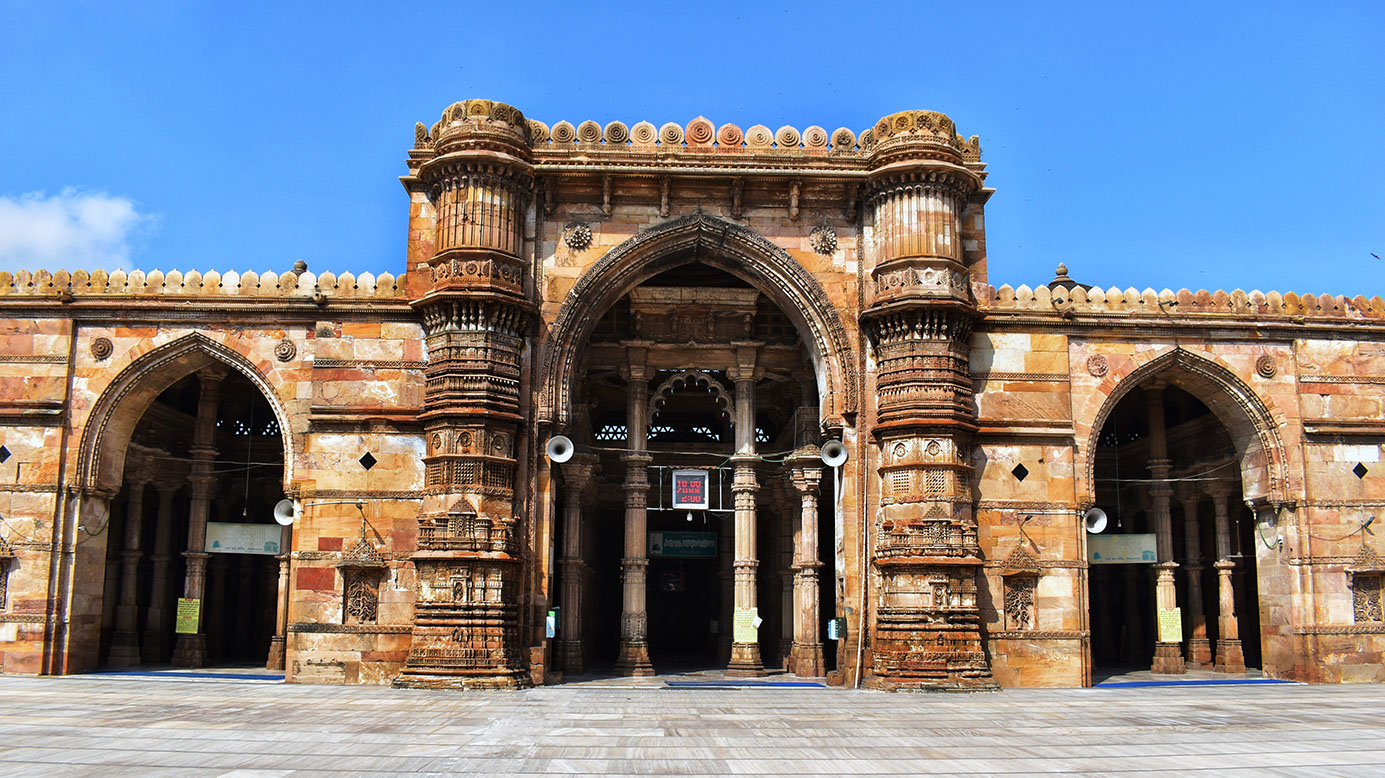
A Journey from Mandir to Masjid
By Rahuldev Rajguru
Last Updated: 23 Oct 2021
Amdavad, that’s how we Gujaratis pronounce the city of Ahmedabad. Wondering what is famous in Ahmedabad? This city where I started my career and spent almost a decade, became the first city to be inscribed on UNESCO World Heritage City in India list in 2017. Owing to this accolade, this buzzing city popularly known for its association with Mahatma Gandhi attracts tourists from all over the world. Ahmedabad is famous for its unique multicultural heritage. Ahmedabad Heritage City is an archeological entity with a complex maze of centuries-old vernacular houses built with finest medieval Indo-Islamic, European and Persian architecture.
Ahmedabad is located on the banks of Sabarmati River. The river divides Ahmedabad into two physically distinct regions, east and west. On the western bank is the city with modern architecture and buildings, developed in the last 100 years. However, the region in the east is the citadel built by Sultan Ahmed Shah in 1411 AD. For decades Amdavadis called it the "old city" but recently the term "The Walled City" was coined for better understanding to the tourists.
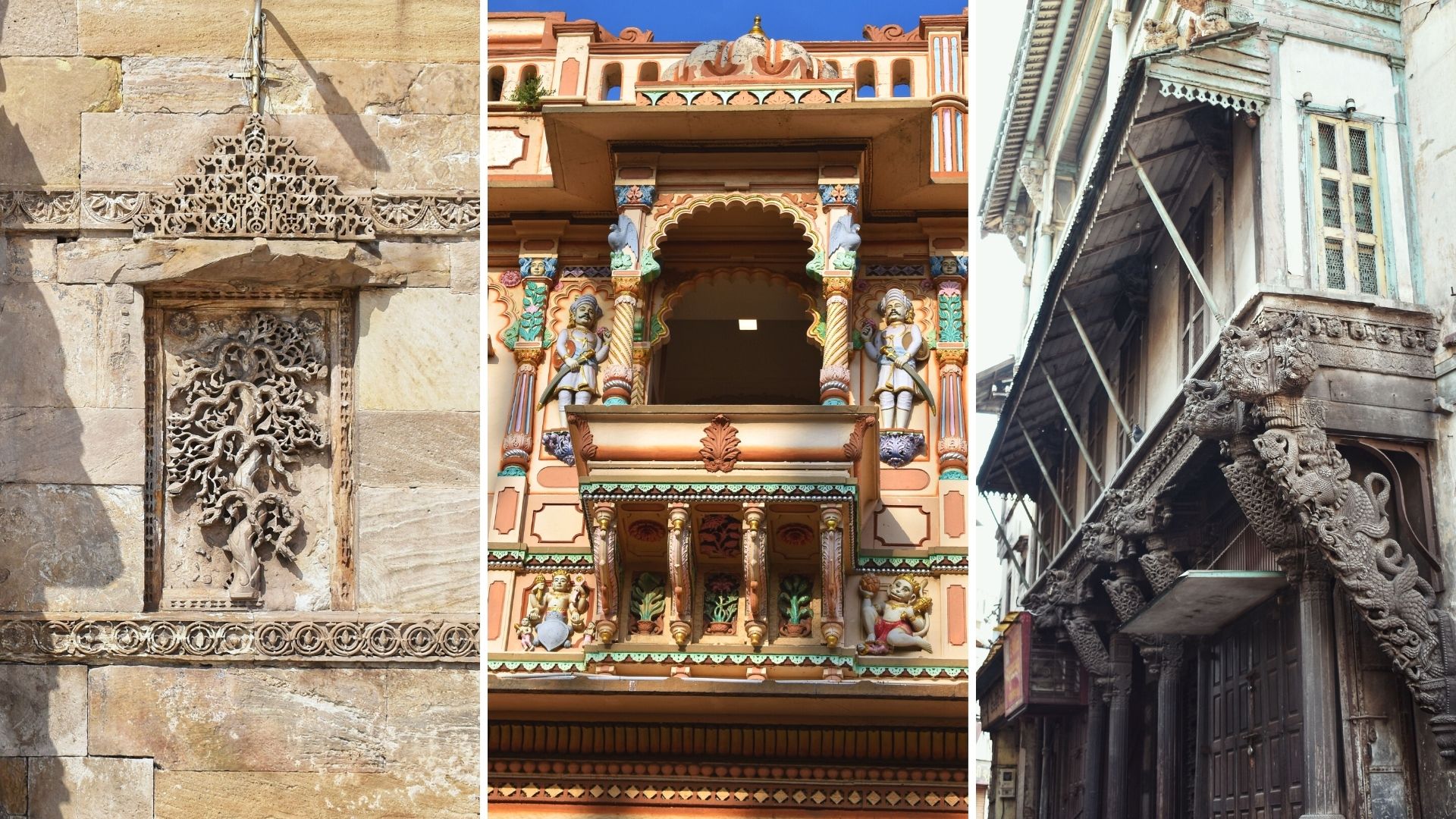
Centuries-old architecture within Ahmedabad's walled city
Among the many things to do in and around Ahmedabad, the heritage walk will remain in your heart for a lifetime. Ahmedabad Municipal Corporation (AMC) and Akshar Travels have designed Heritage Walks to experience the fusion of heritage & architecture embedded in ancient temples, mosques and historical sites near Ahmedabad. This 2-hour guided tour starts at 7.45 am from Swaminarayan Temple in Kalupur and ends at Jami Masjid at 10 am, covering 2 kilometers. Usually, prior booking is recommended but due to Covid, inflow of tourists to Ahmedabad was limited hence, I didn't have to make a prior booking. It costs Rs. 200 per person.
This is one of the most densely populated areas of Ahmedabad with narrow roads and complex navigation. Traffic is usually quite heavy, and there are almost no 4-wheeler parking facilities nearby. Although you won't face traffic issues early in the morning, you will after the tour is over. This place is well connected by public transportation, so that's the best way to get here. There is a limited parking facility inside the temple, and heritage walk visitors are permitted to use it. However, their parking usually fills up quickly. There is a wide variety of hotels in the "walled city of Ahmedabad".
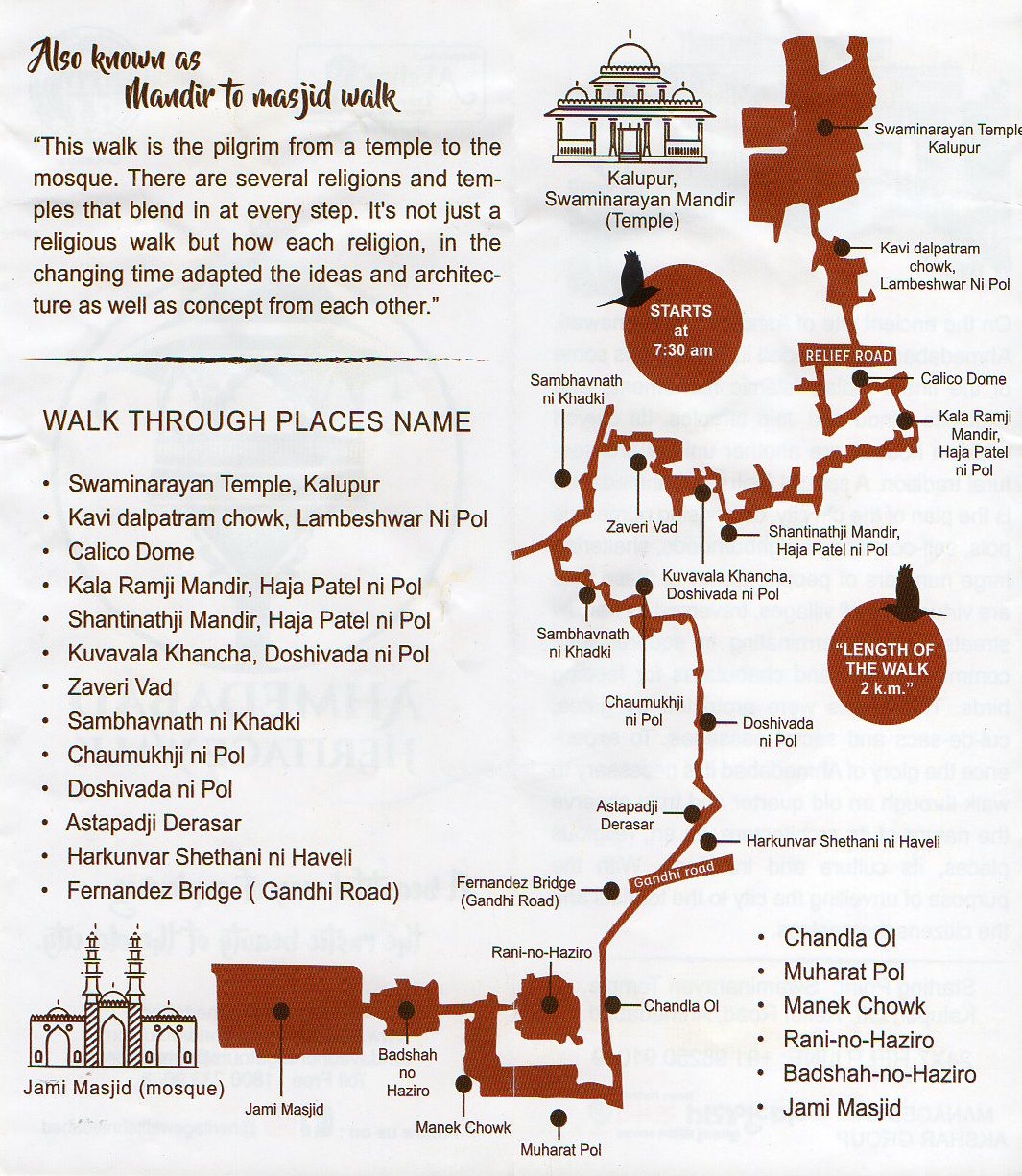
Route map of the guided heritage walk
In an effort to highlight the properties in the UNESCO World Heritage City in India and make it easily identifiable, these buildings are graded into 4 grades using blue and grey plaques. Grade I signifies monuments of very high historic and architectural significance including religious places. Grade II(A) signifies buildings that are 150 years old. Grade II(B) signifies belonging to different time periods. Grade III signifies buildings that are 100 years old.
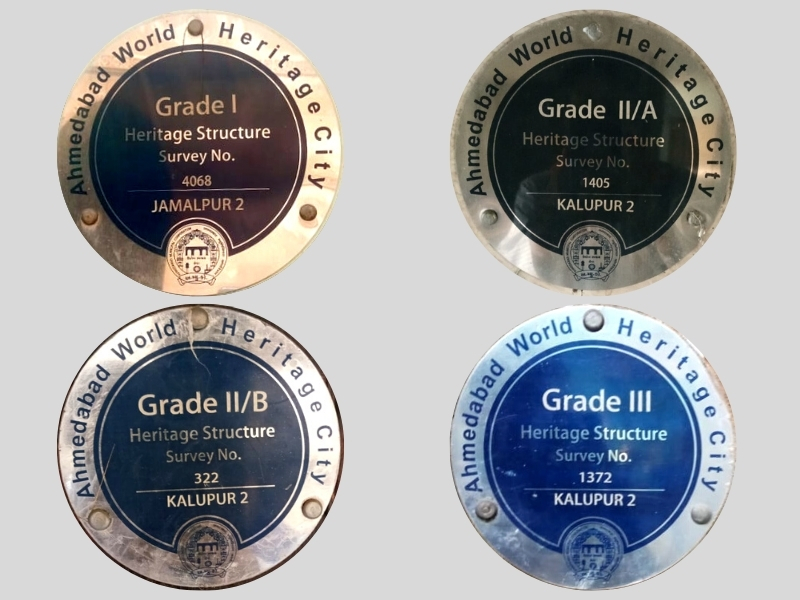
Swaminarayan Temple - Starting point of Ahmedabad Heritage Walk
I reached Swaminarayan Temple at 7.30 am and luckily, found car parking inside the temple. The walk starts with a screening of a 15-min documentary film on the history, monuments and other places of Ahmedabad, the first UNESCO World Heritage City in India. After a 5-min break to offer prayers in this 200-year-old temple and take some pictures, the walk began at 8 am.
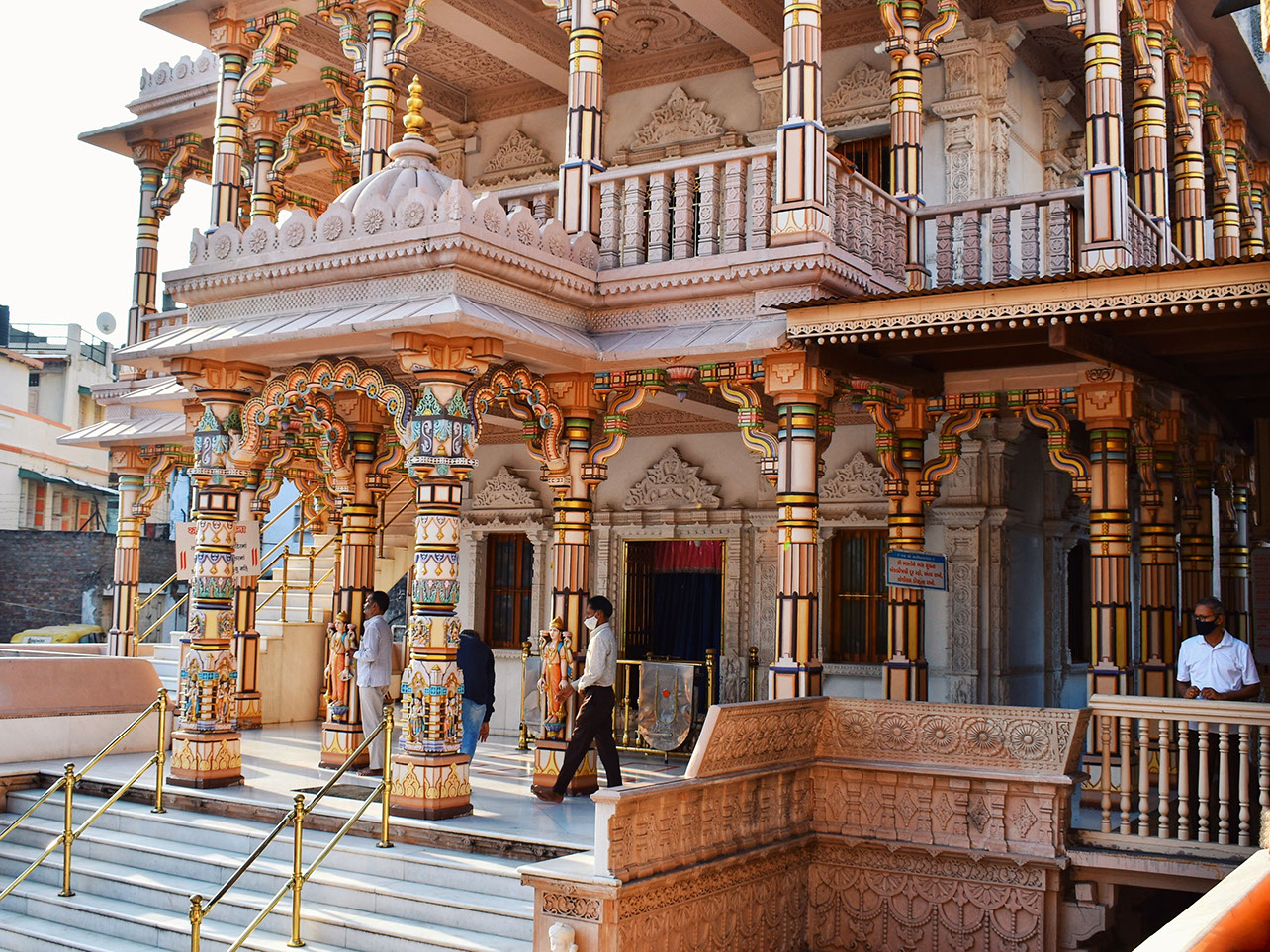
Colorful pillars with intricate carvings on Burma Teak and natural colors
This is the first temple of Swaminarayan Sampraday (religious sect), built in 1882 from the land gifted by the British Imperial Government. This religious icon is a cultural heritage of Gujarat.
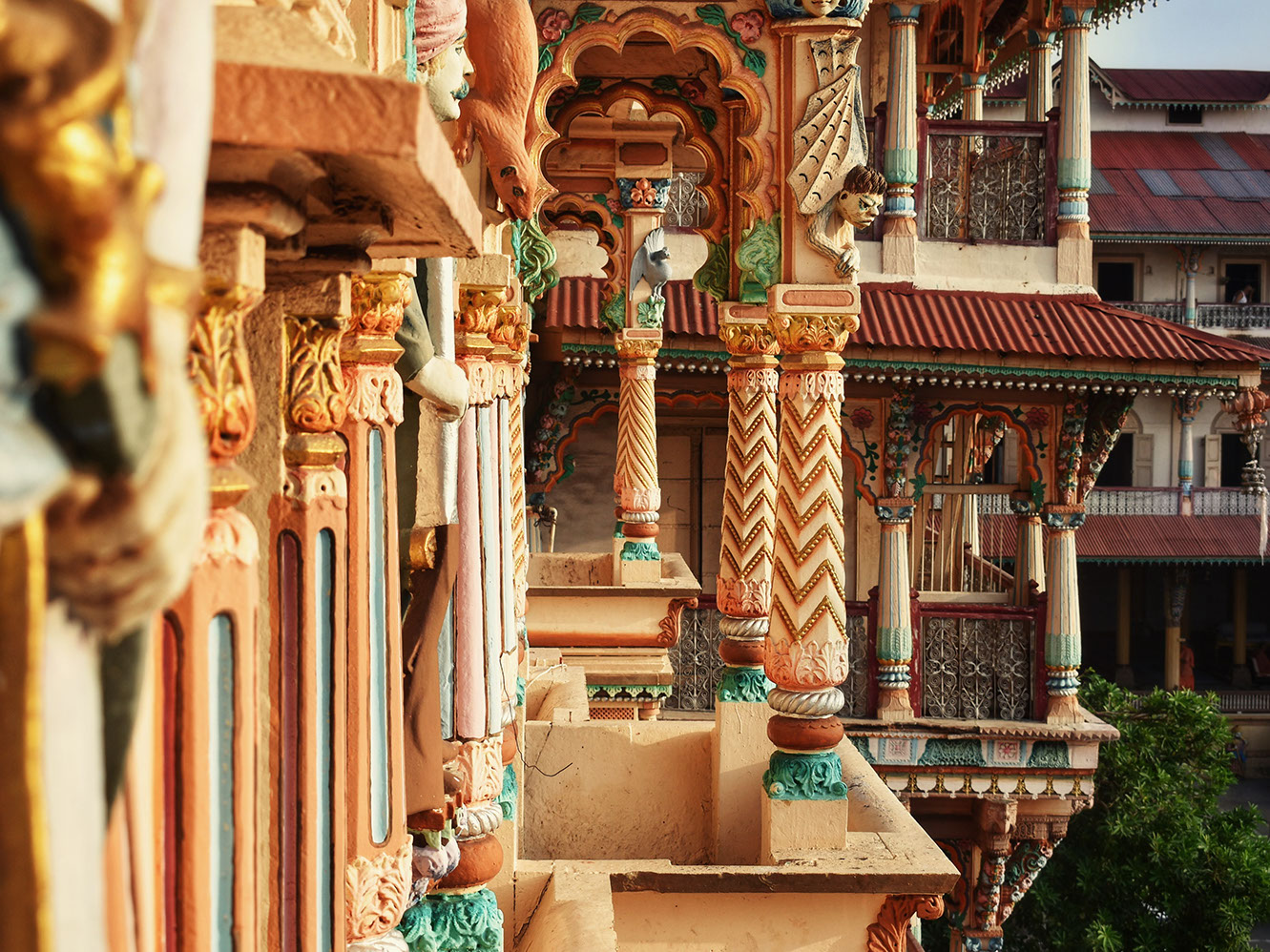
Sculpted wooden pillars showcase rich culture & traditions of Gujarat
Being a weekday, we were only 2 people making it a more personalized tour. Our guide Murtuza Bhai was highly knowledgeable and passionate which enhanced our experience. It is a tradition in Gujarat to address a male with "bhai" (brother) and a female with "ben" (sister) followed by their names to show respect.

Kavi Dalpatram Chowk - A Live Memorial
Our first stop was at Kavi Dalpatram Chowk located in Lambeshwar ni Pol. Chowk is a place in the center of a community neighborhood where people come together to socialize. This is a LIVE memorial of Gujarati poet reformer Kavi Dalpatram Dahyabhai ("kavi" means poet). Heard of a live memorial before? Well, Murtuza Bhai explained that memorials usually have a standing statue but here is a sitting statue which communicated a clear message. It was an invitation for people to come together and socialize.
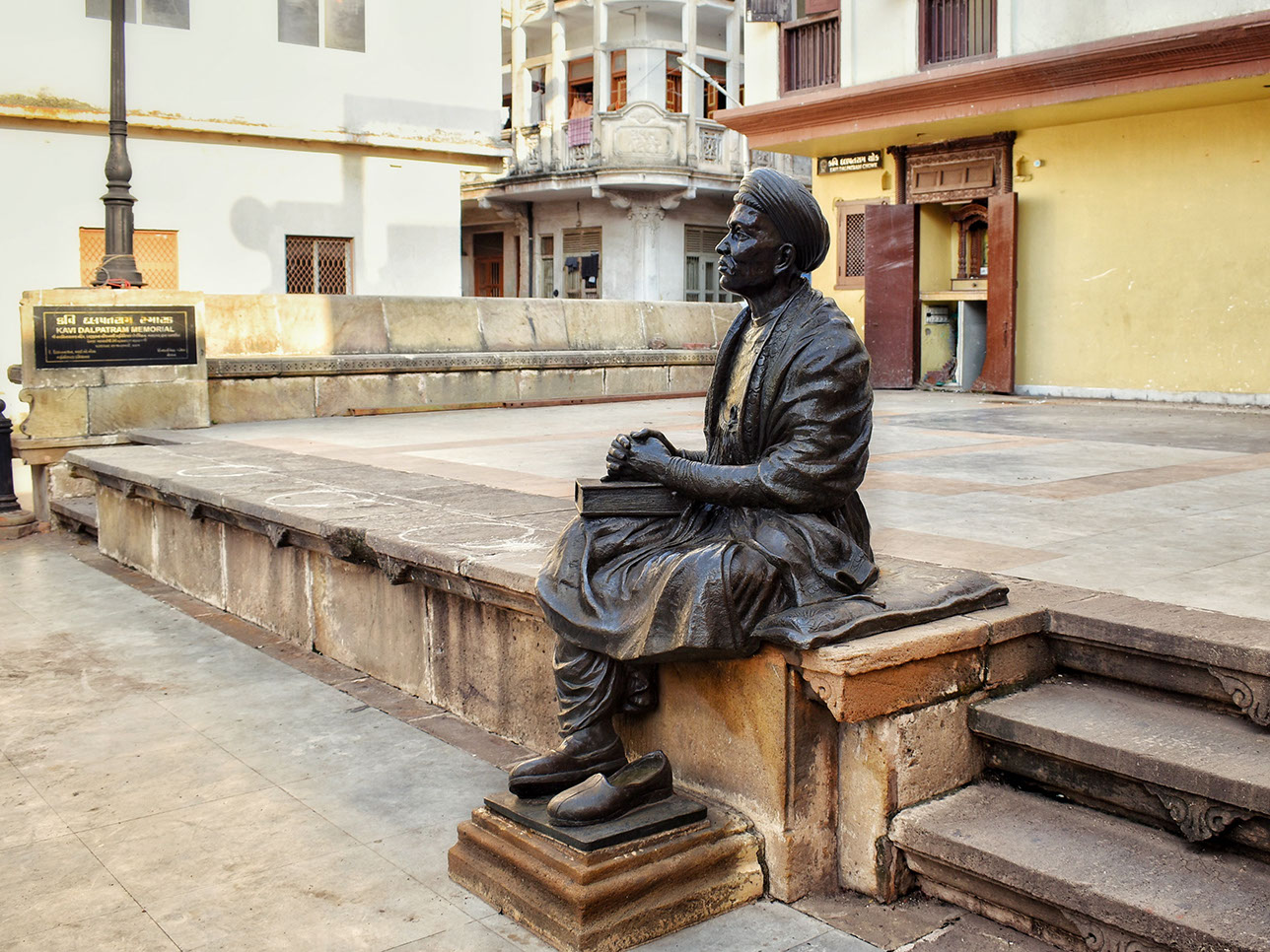
The statue made of Ashtadhatu (eight metals) is put on a facade that resembles the house of Kavi Dalpatram (1820 - 1898)
The other striking aspect of this statue is the posture. The Kavi sitting with his left leg folded removing one of his shoes is reminiscent of an age-old Indian culture. Does it not remind you of childhood days when you bonded closely with grandparents sitting on their lap and walking in their shoes? That is exactly what this posture communicates, a message of love and bonding.
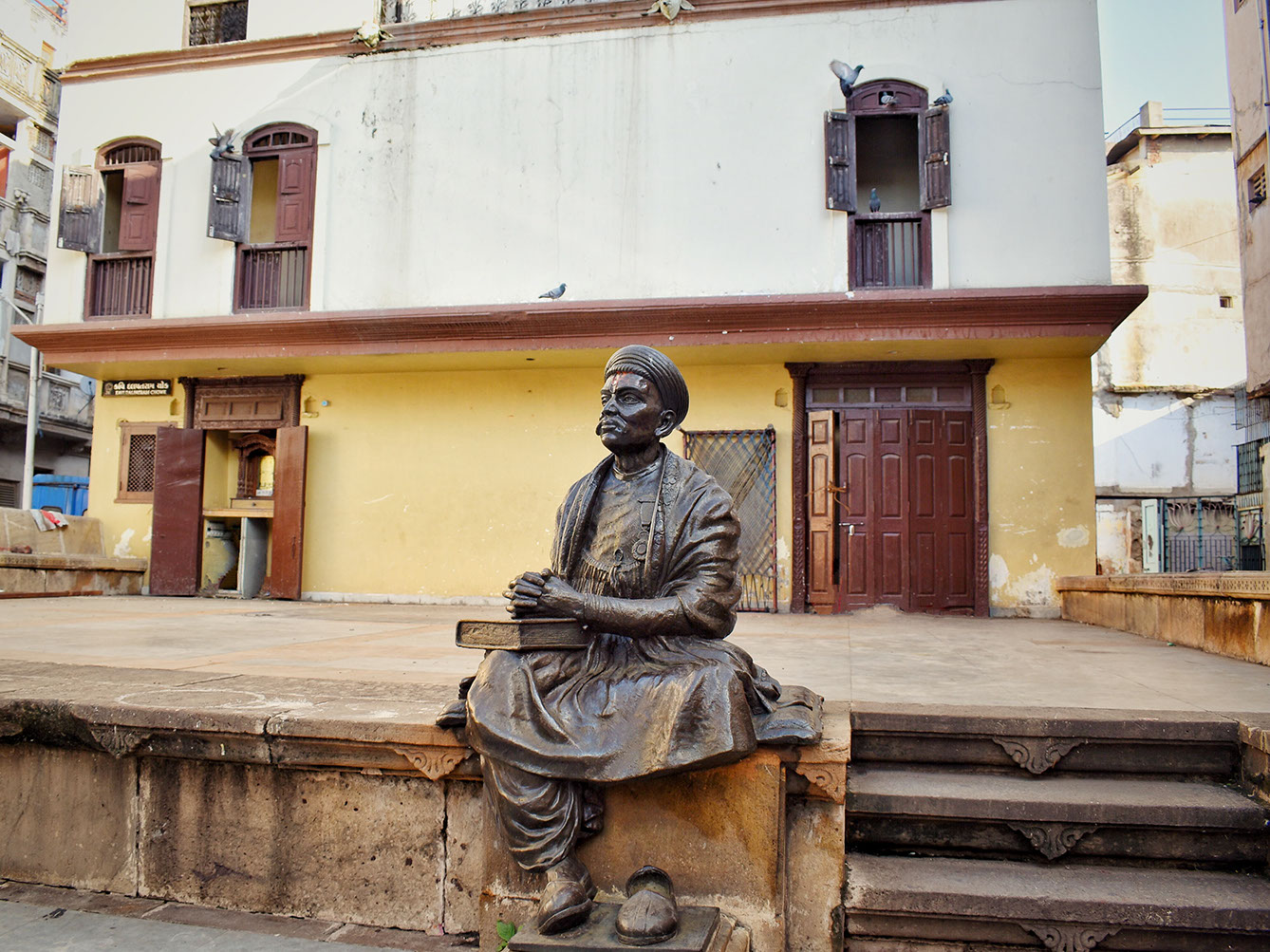
Intricately crafted statue of Kavi Dalpatram
Ahmedabad Pols - ancient gated communities
This UNESCO World Heritage City of India is nestled with hundreds of "Pol" situated adjacent to each other. "Pol" means "gated community". Each Pol has a unique name signifying historical places in Ahmedabad or the community living there e.g. Hindus, Muslims, Jains, etc. There are four things common in each Pol.
- Entrance gate
- Observation cabin atop the gate
- Place of worship
- Chabutaro
Imagine, the modern day concept of "Gated Community Living" existed a few hundred years ago in Ahmedabad Heritage City. Amazing, right?
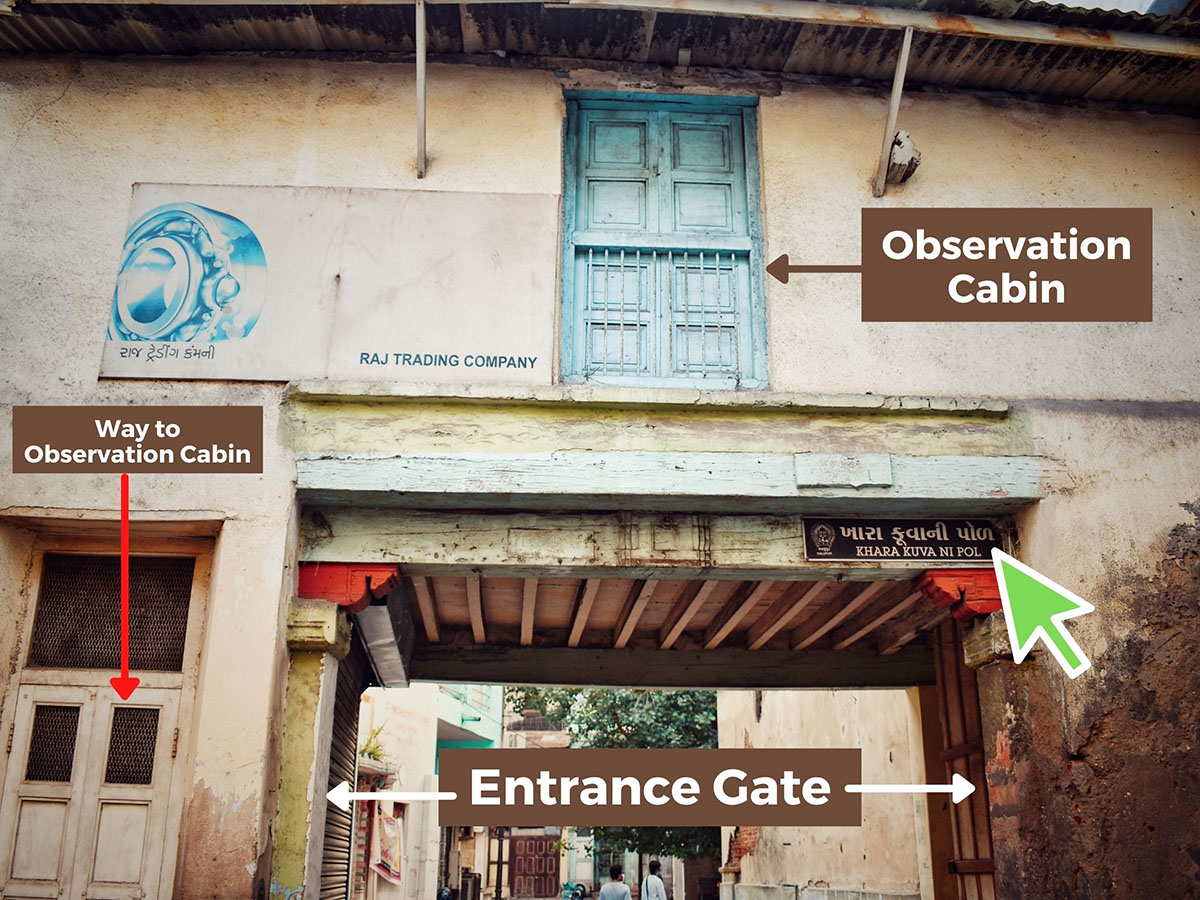
Khara Kuva's (a well with salt water) Pol in Ahmedabad old city
The walled city is crowded with little space for trees and plantations. Surprisingly, it attracts a huge number of birds, more than the new city that has many trees. "Chabutaro", an octagonal pavilion mounted on a tall column is a common sight here. The word Chabutaro is derived from "Chabutar" (Pigeon). These structures are shelters for birds providing them with food and water. The ladder used to reach the top of the pavilion is rather steep, intentionally designed to curb dogs and cats from climbing up and devouring the birds' feed and water.
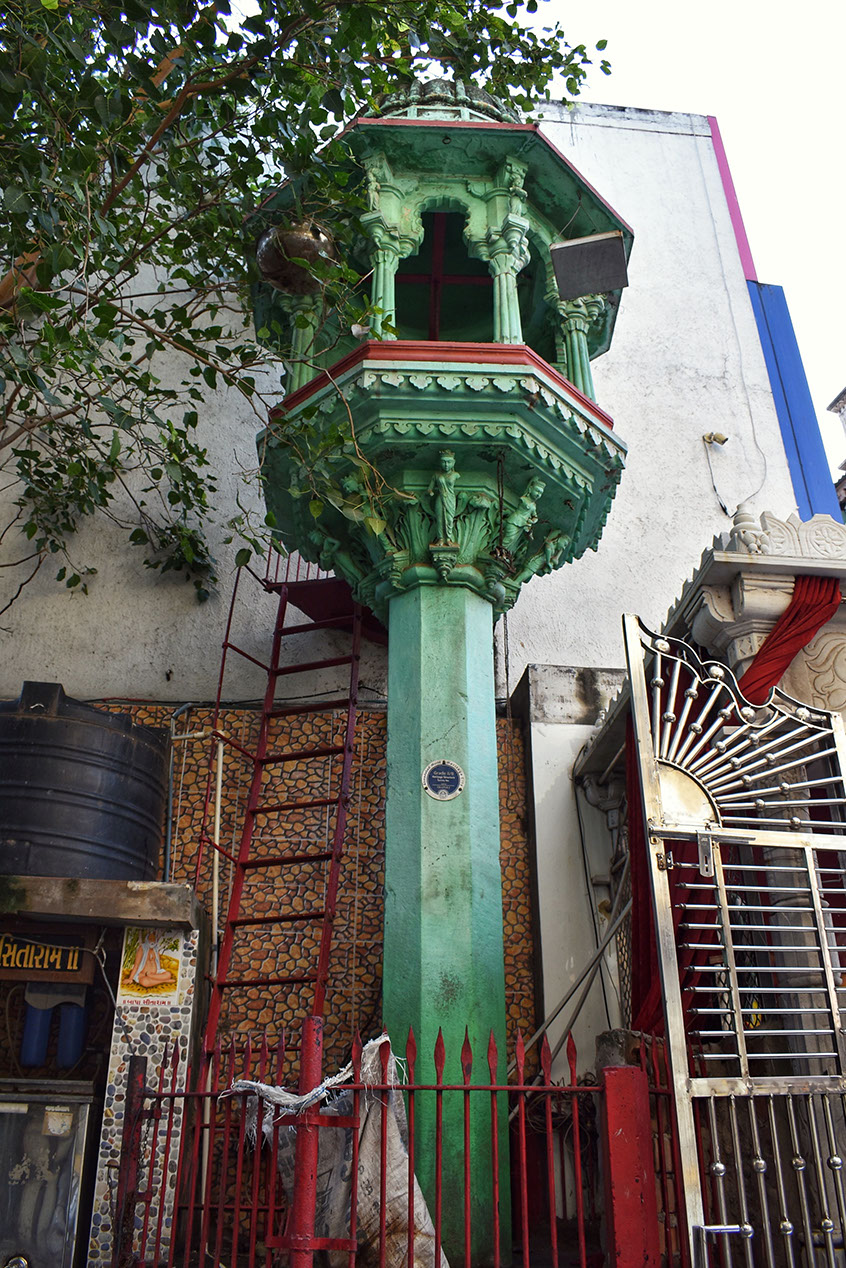
Chabutaro - a symbol of Gujarati hospitality
When a massive earthquake wreaked havoc in Ahmedabad's new city in 2001, casualty in the old city was expected to be magnanimous due to centuries-old buildings that connected to each other wall-to-wall. Surprisingly, there was minimal damage, wondering why? These old buildings were built with teak wood columns and wall-to-wall support. Teak wood possesses elasticity so during the earthquake these pillars adjusted its shape and realigned without breaking. Concrete pillars on the other hand gave in to the force of nature.
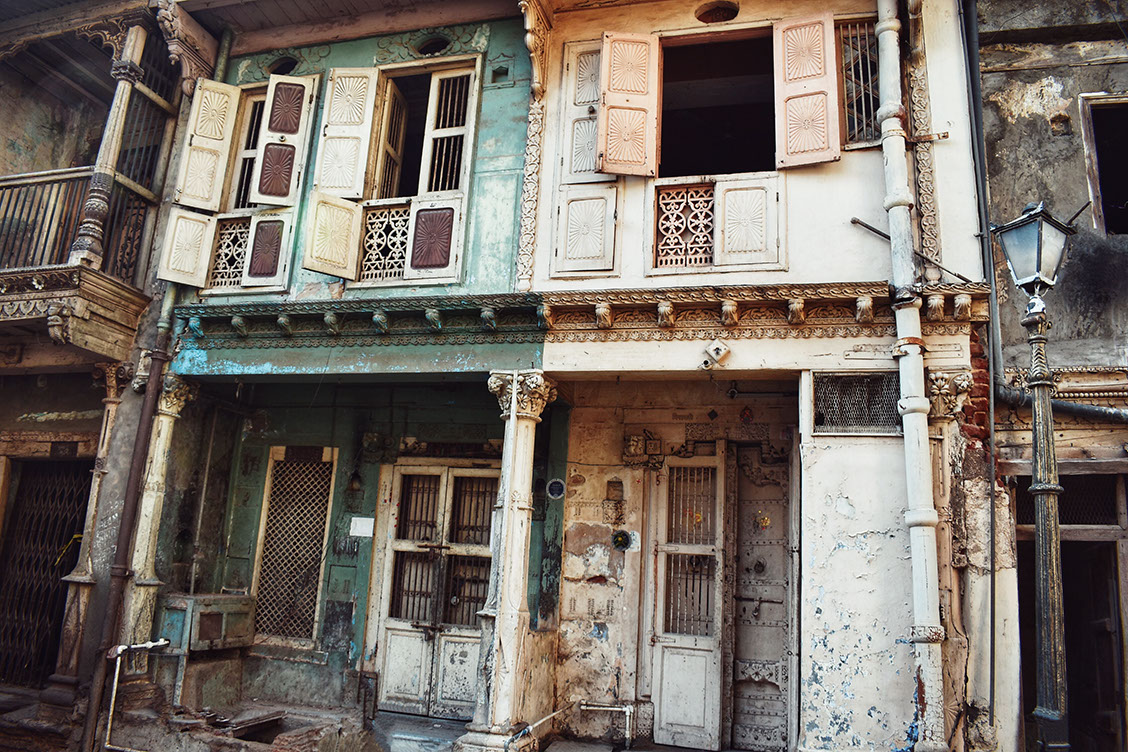
Wall-to-wall design of old houses with resilient teak wood pillars
Building a city so dense requires major town planning. Sewage engineering became a big challenge and they found the perfect solution, underground sewage system, during the early 19th century. The underground sewage system was connected to a towering pole with an arrow at the top that indicates a direction.
The above image of the pole clearly shows the arrow and vent. This pole serves two purposes. Firstly, it indicates the direction of the underground sewage flow to guide staff during maintenance work. Secondly, it serves as a vent to exhaust carbon monoxide. Interestingly, the poles are very tall and the vent is placed away from the house so as to not inconvenience the residents. Very thoughtful and detailed.
Ever wonder why Sultan Ahmed Shah built a walled city instead of a fort? He built the walled city to protect the people and historical places in Ahmedabad from invaders. At the same time, being a shrewd businessman, he wanted to open access to foreigners for trade. The city had secret escape routes in case of an invasion. The difference was these routes were not secret anymore, confused? Well, the passages were designed to make them look like normal houses or streets to strangers but the locals knew the secret routes.
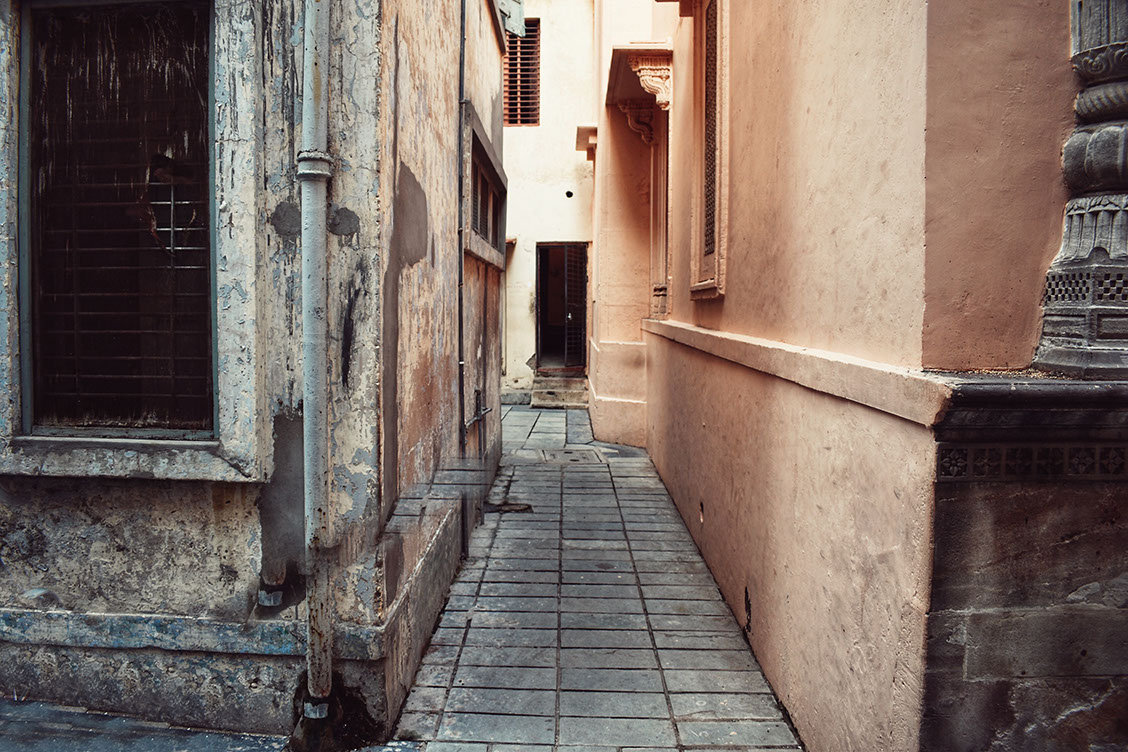
Secret passage connecting Pols with short cuts
Kala Ramji Temple is a 350-year-old ancient Lord Rama temple located inside a huge haveli (religious mansion). There are only two Lord Rama temples in India where the idol is seated and without Lord Hanuman, this being one of them. It is also the only Lord Rama temple in Gujarat with black stone idol.
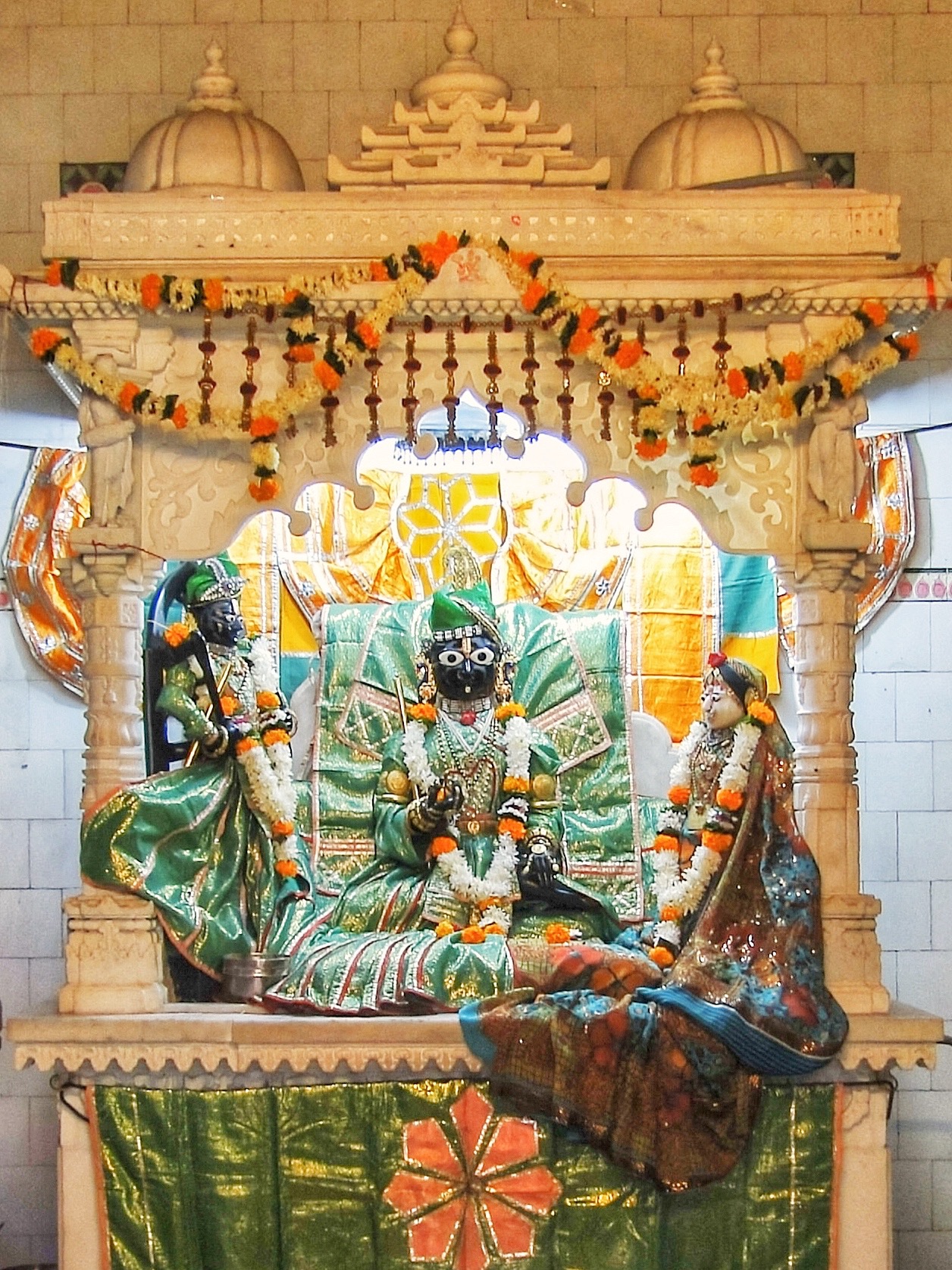
Kala Ramji temple with Lord Rama, Laxman and Sita without Lord Hanuman
Kuvavalo Khancho - Cosmopolitan Architecture
Ahmed Shah was a muslim ruler and hence, the name Ahmedabad. However, the city was not dominated by islamic architecture. The cosmopolitan culture of Ahmedabad Heritage City is evident when you visit Kuvavalo Khancho (the intersection of a well and a passage). This place has 4 homes opposite to each other with distinctive Persian, Maratha, Mughal and Colonial architecture. After more than 100 years, these houses still have the respective original emblems above their doors.
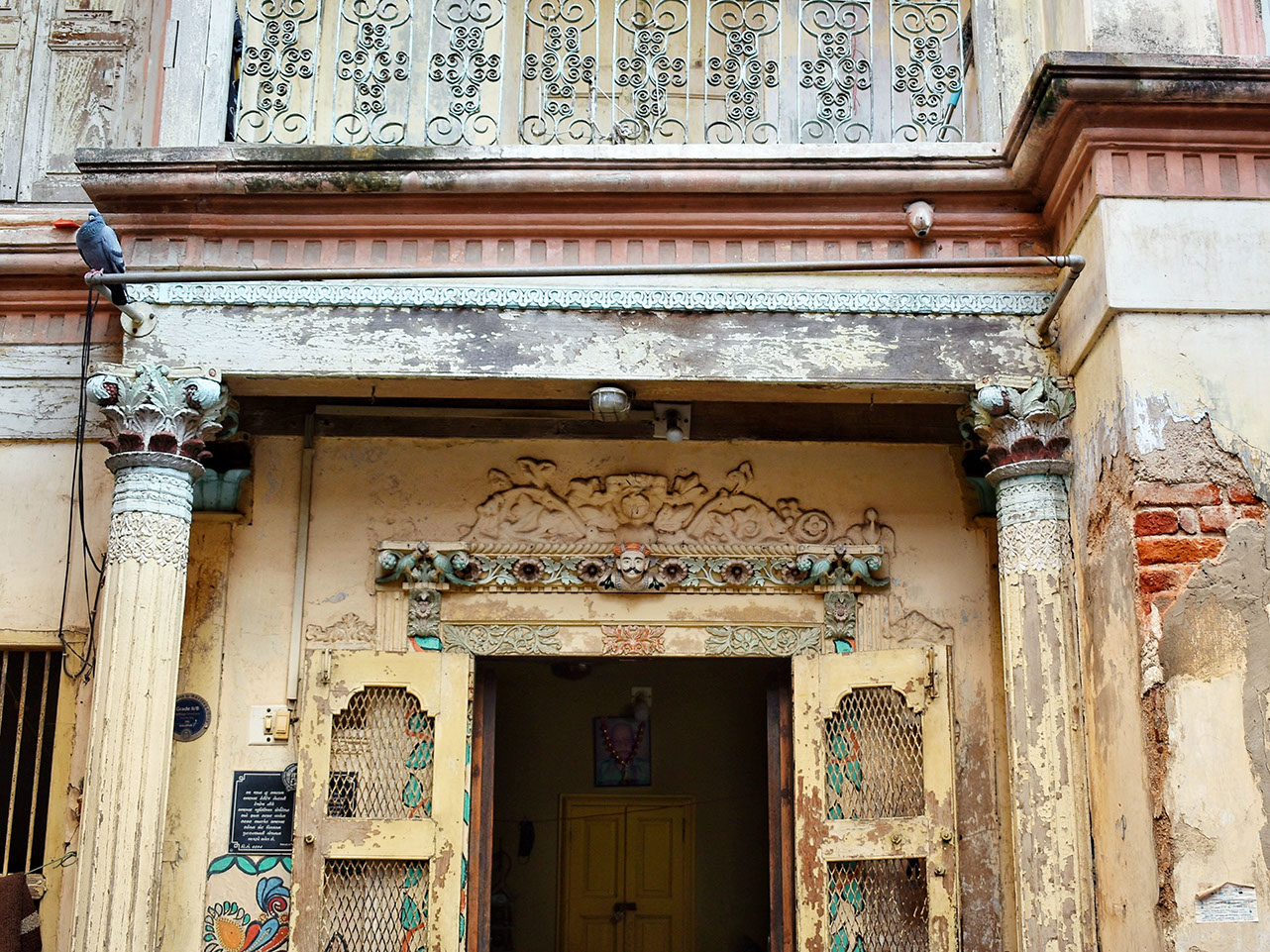
Maratha architecture
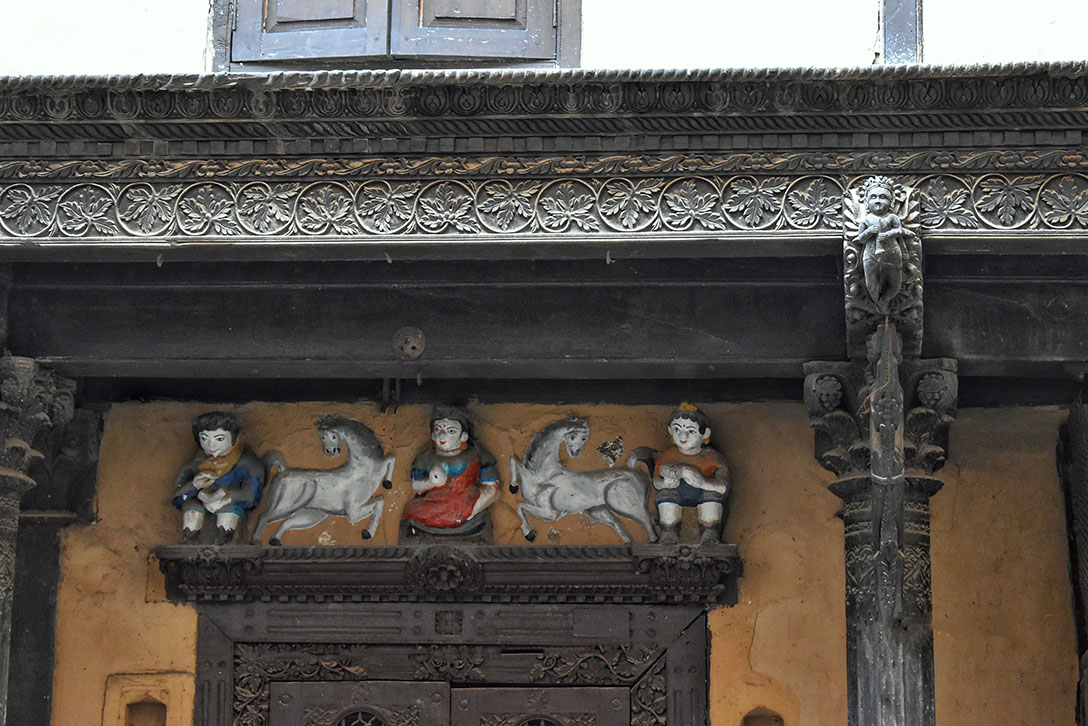
Colonial architecture
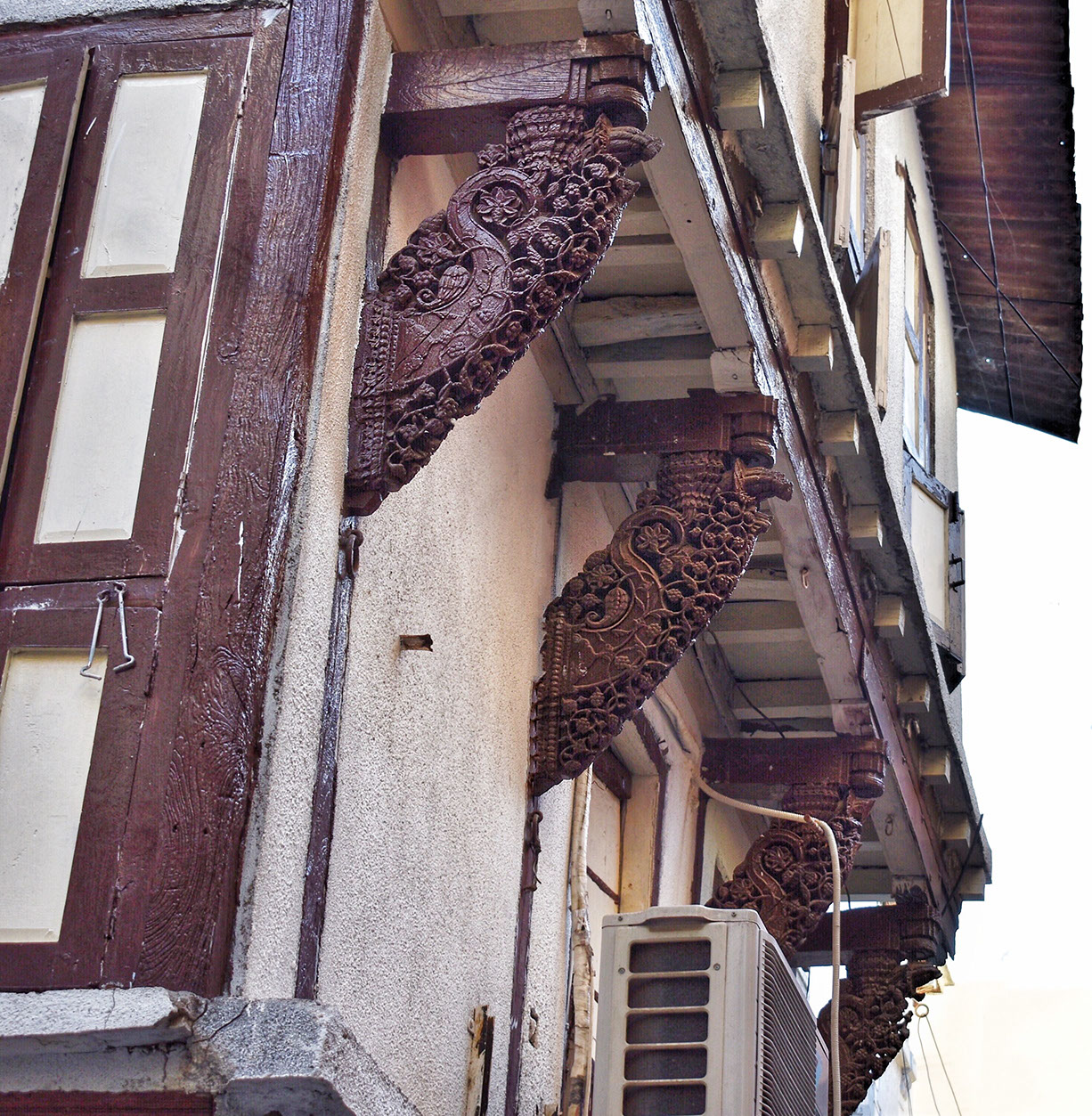
Persian architecture
Gujaratis are a kind hearted community with love for all living beings, a common aspect of Jainism. This is seen even in the way their houses are built. They have close-ended holes in their outer walls to provide shelter to Parrots and other birds called "Popatna Gokh" (Parrot holes).
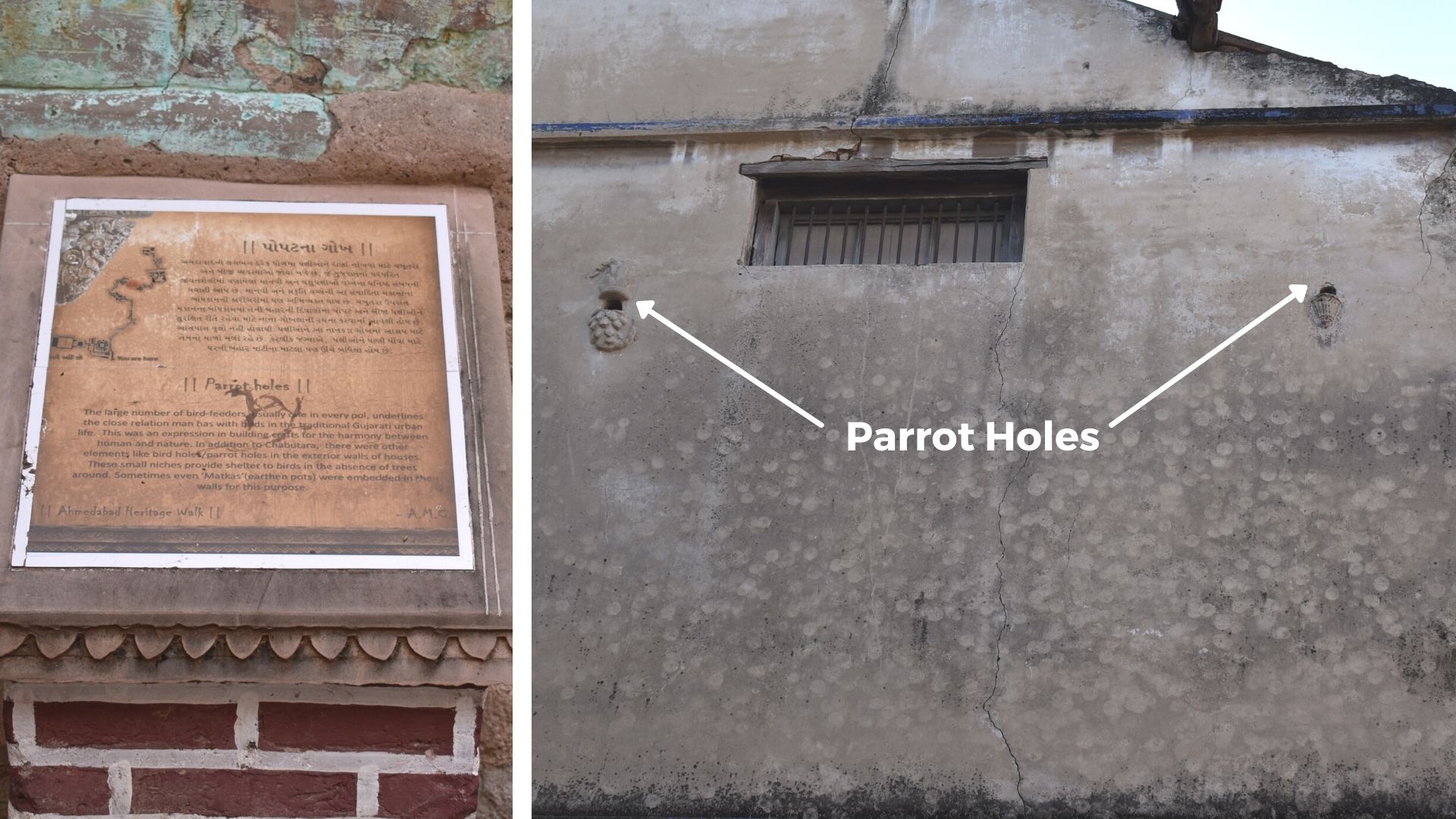
Example of harmony between humans & nature
Overwhelmed by this rich heritage, one would like to stay in the Pols and experience this culture firsthand, right? Well, not to worry, Airbnb has already reached the walled city. Doshiwada ni Pol is famous for its rich traditional havelis (mansions) with intricately decorated facades. If you wish, you may book your stay at the Dodhia Haveli and get a first-hand experience of daily life in the walled city of Ahmedabad
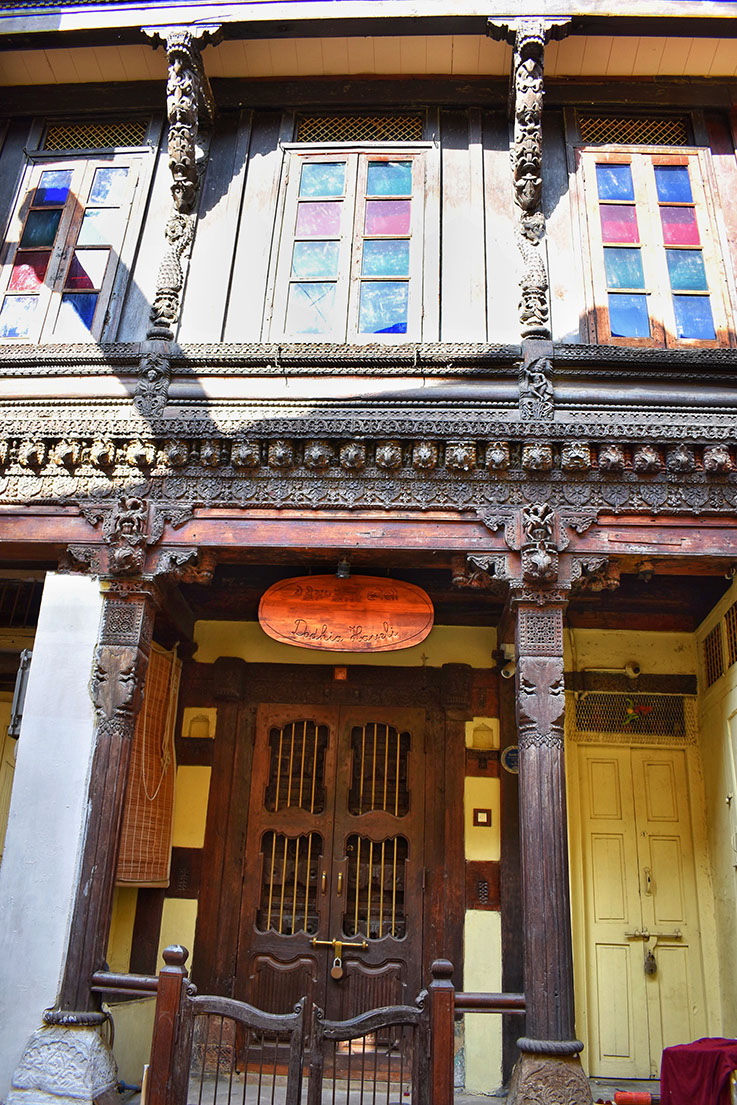
Dodhia Haveli offers a holistic experience
Doshiwada ni Pol houses the goldsmith community comprising wealthy people following Jainism. At the end of this Pol, lies Ashtapadji Mandir, a Jain temple that was built in 1856. This beautifully architected temple has ornate balconies with sculptures of human figures in dancing poses.
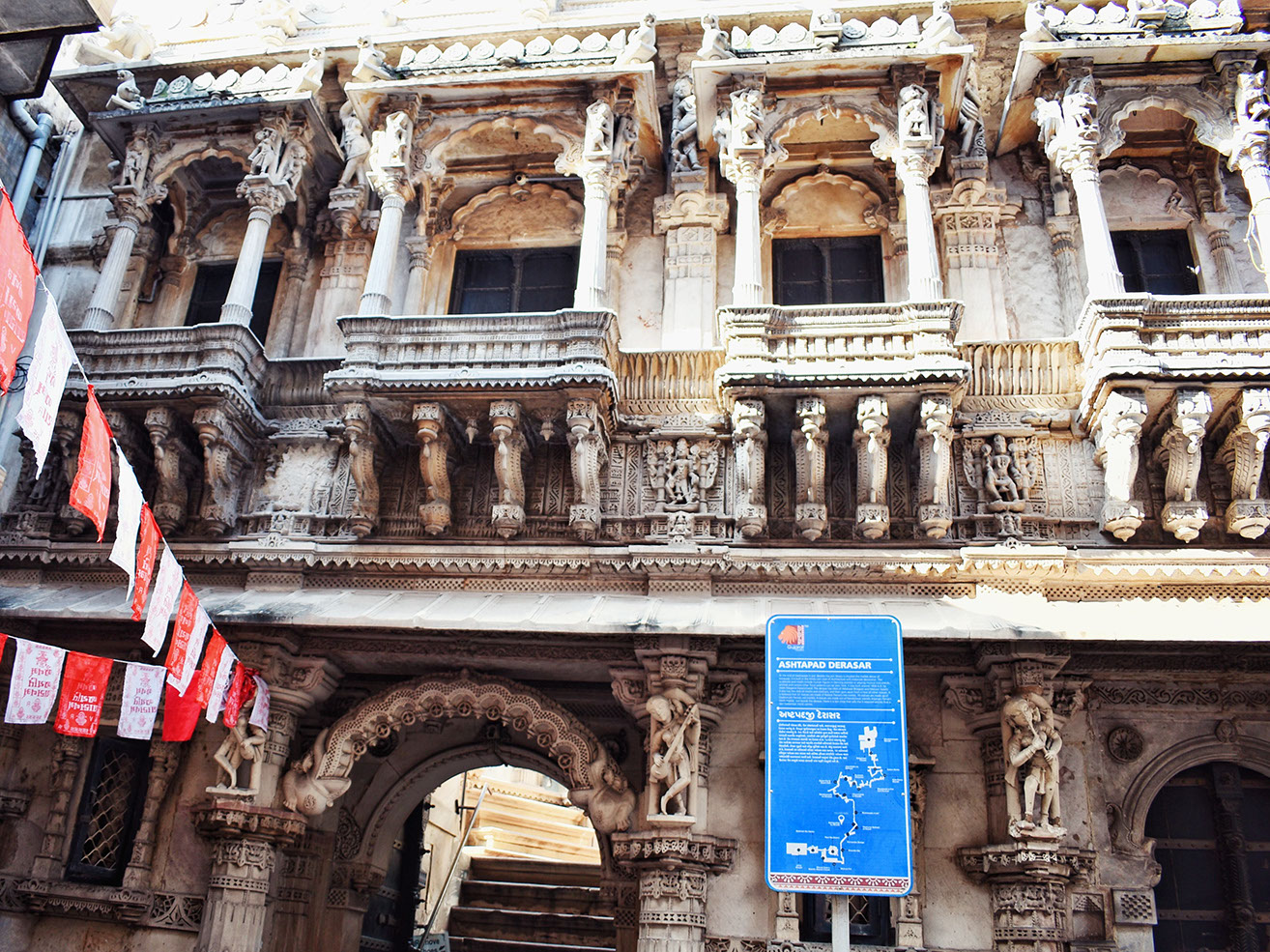
An ancient Jain temple entirely built with red & black marble stones
This 180-year-old 3-storied Harkunvar Shethani's Haveli with 60 rooms is an architectural masterpiece. It features Indo-Chinese architectural elements with wooden brackets supporting this multi-storey building.
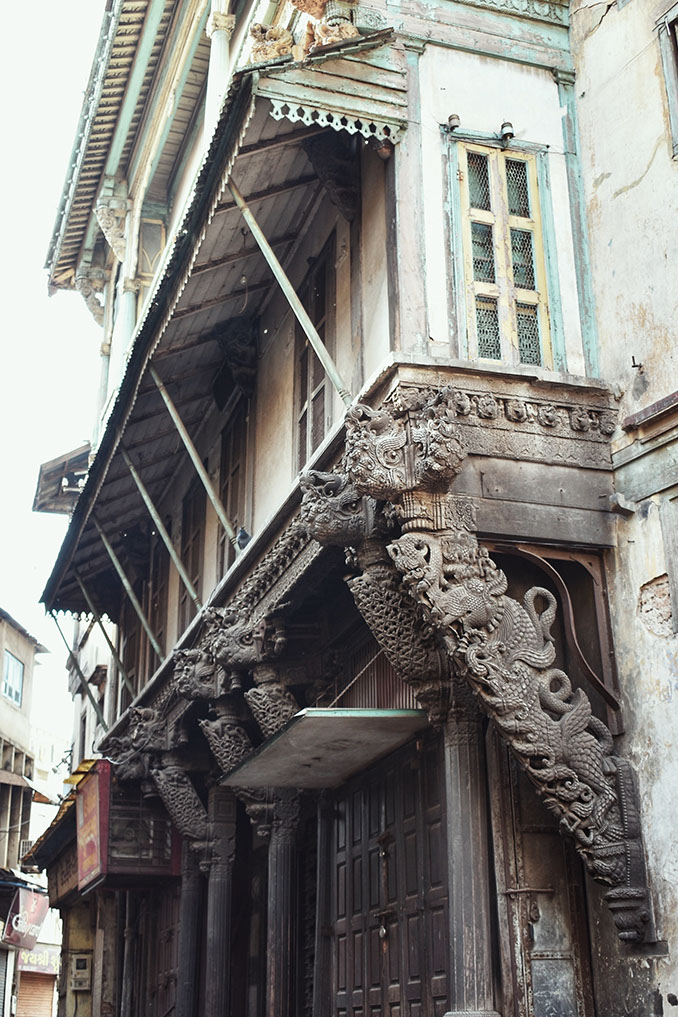
The wooden carvings of Elephant and Dragon
Ahmedabad walled city is divided into 3 sections, residential area, commercial (market) area and OL. The Ol area is where shop owners have their shops and homes in the same building with entry to the home through the shop.
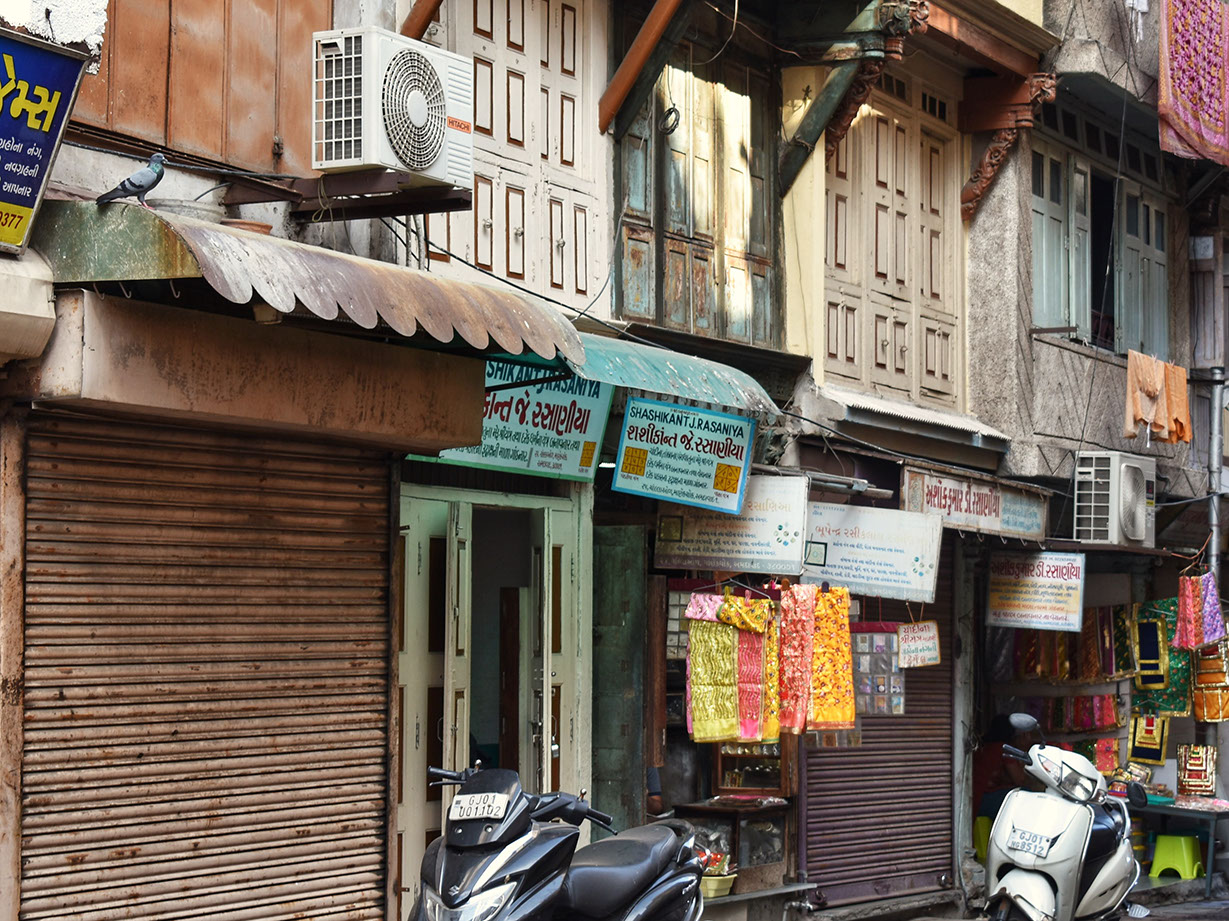
Buildings with shops on the ground floor and owner's home above it
The tour continues to witness exquisite islamic architecture evident in masjids (mosques) as we move to Muslim residential area that houses tombs of royal families and Ahmed Shah, the founder of Ahmedabad now India's first heritage city. These places are known as Badshah No Hajiro (Emperor's Tomb) and Rani No Hajiro (Queen's Tomb).
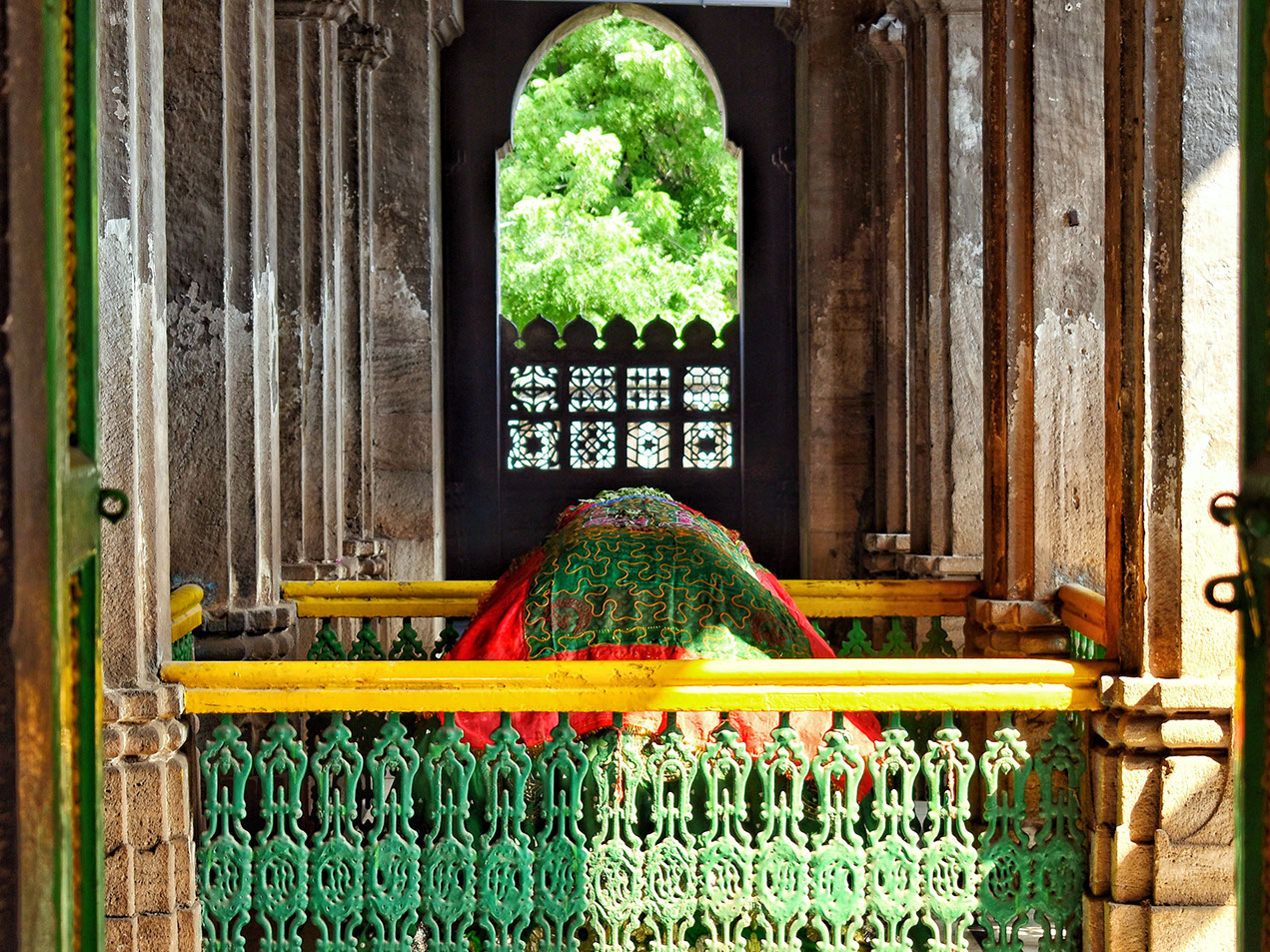
Colorful chadar (carpet) covers Badshah No Hajiro
For centuries, Gujaratis are known for their entrepreneurial skills and business acumen. Ahmedabad is famous for the Ahmedabad Stock Exchange within the walled city, which was established more than 100 years ago.
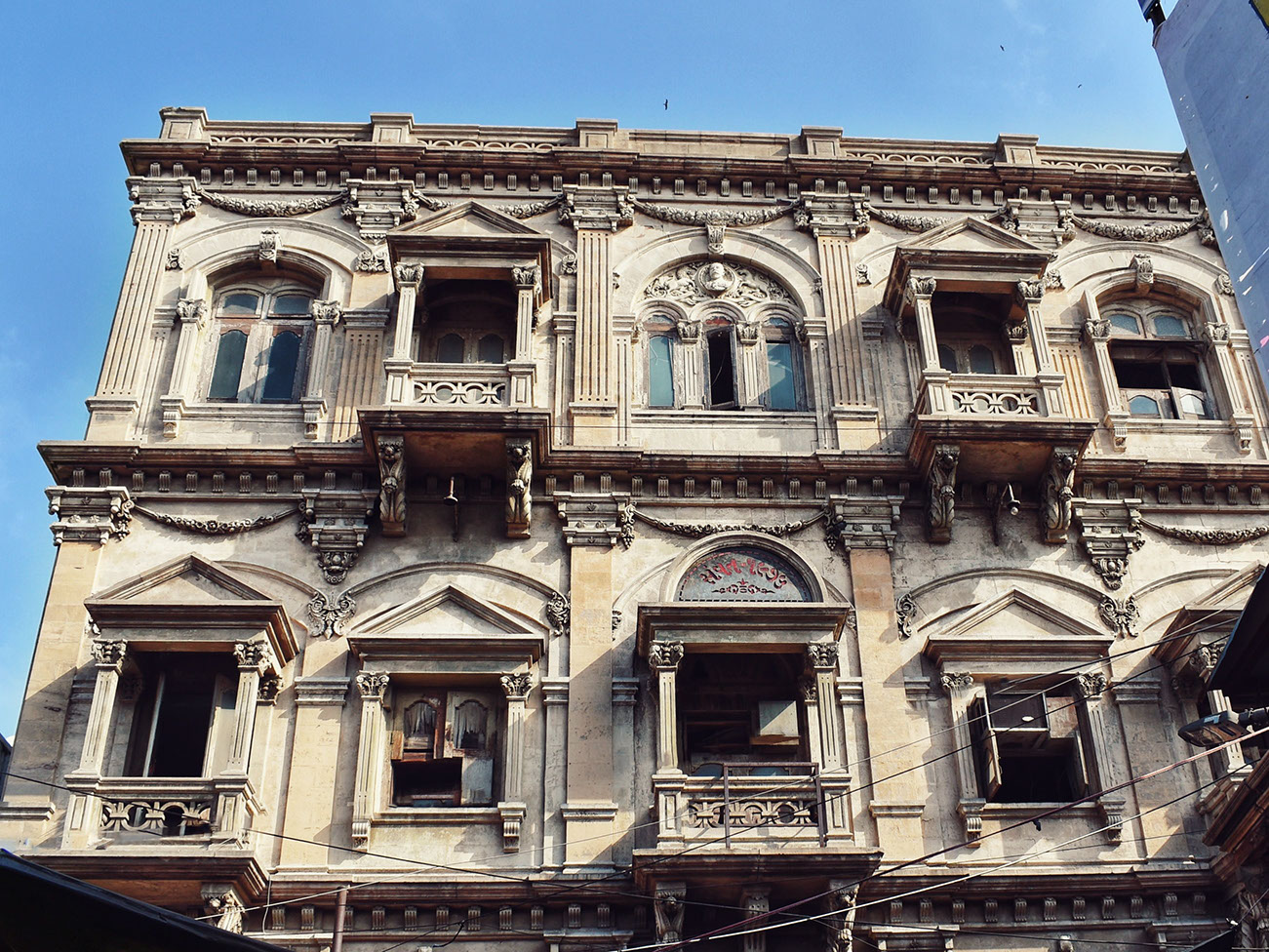
Dilapidated building of Ahmedabad Stock Exchange known as "Sher Bajar"
While trading in stocks, Gujaratis believe in "Mahurat" (auspicious moment) trade to start their trading activities. Hence, the Stock Exchange was built exactly opposite the "Mahurat Pol", the first Pol in Ahmedabad Heritage City.
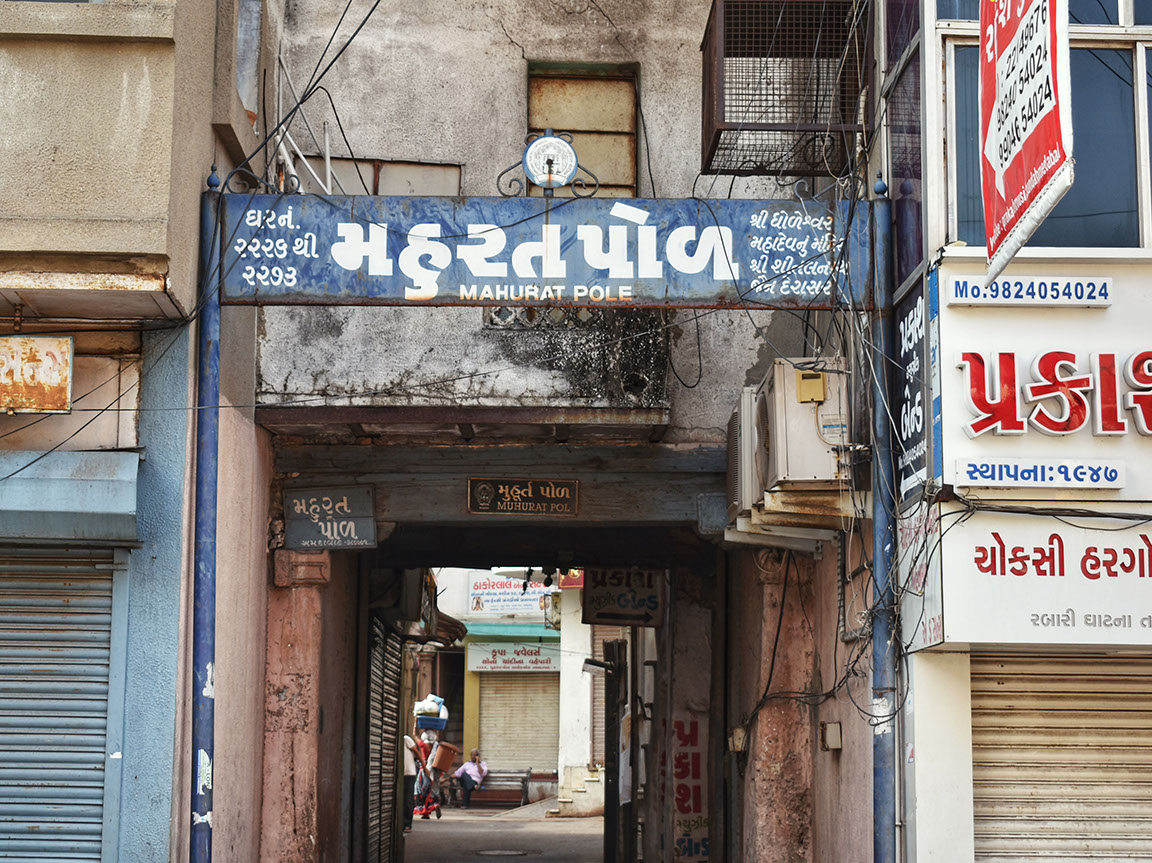
Mahurat Pol was founded in 1460
Manek Chawk - the happening place
Manek Chawk is the epicenter of the walled city be it day or night, for different reasons. It is named after Saint Maneknath, the then advisor of Sultan Ahmed Shah, a key figure in the development of Ahmedabad Heritage City. From a vegetable market in the morning, a bullion market in the daytime and a vibrant street food hotspot for almost the entire night, Manek Chawk is multifaceted.
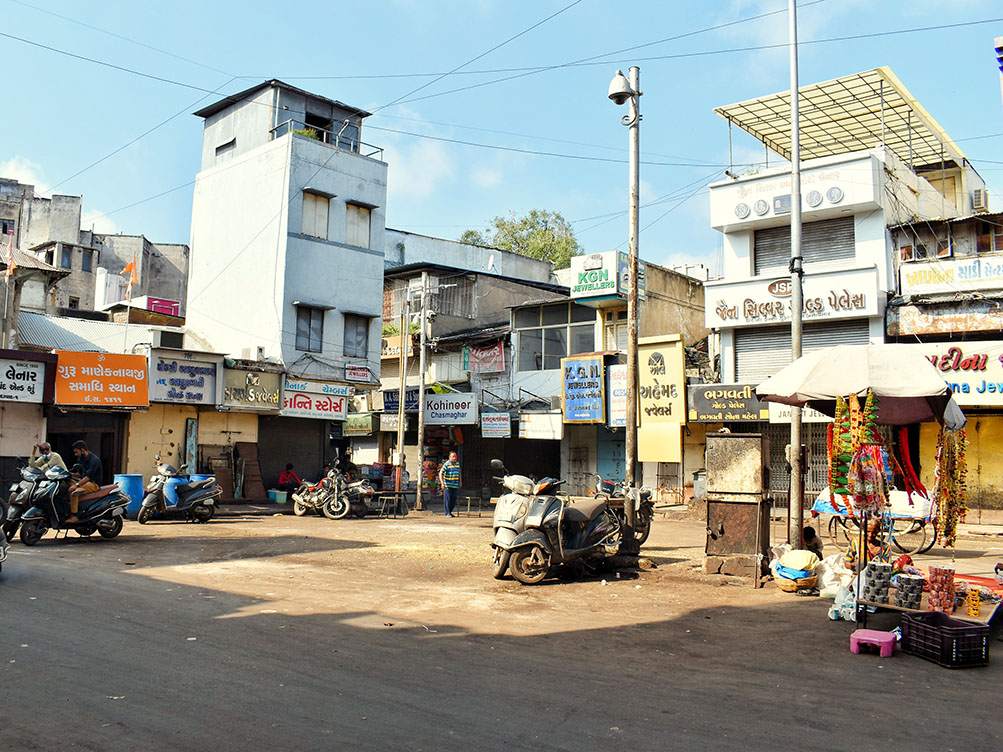
Manek Chowk, a big bullion market but no special security needed
Jami Masjid in Ahmedabad old city
Our heritage walk ended at a famous masjid (mosque), Jami Masjid. Built in 1424, it is believed to be the largest mosque built in India in the 15th century. The sprawling campus has 4 entrance gates, each having a different name inscribed, Jami Masjid, Jamma Masjid, Jumma Masjid.
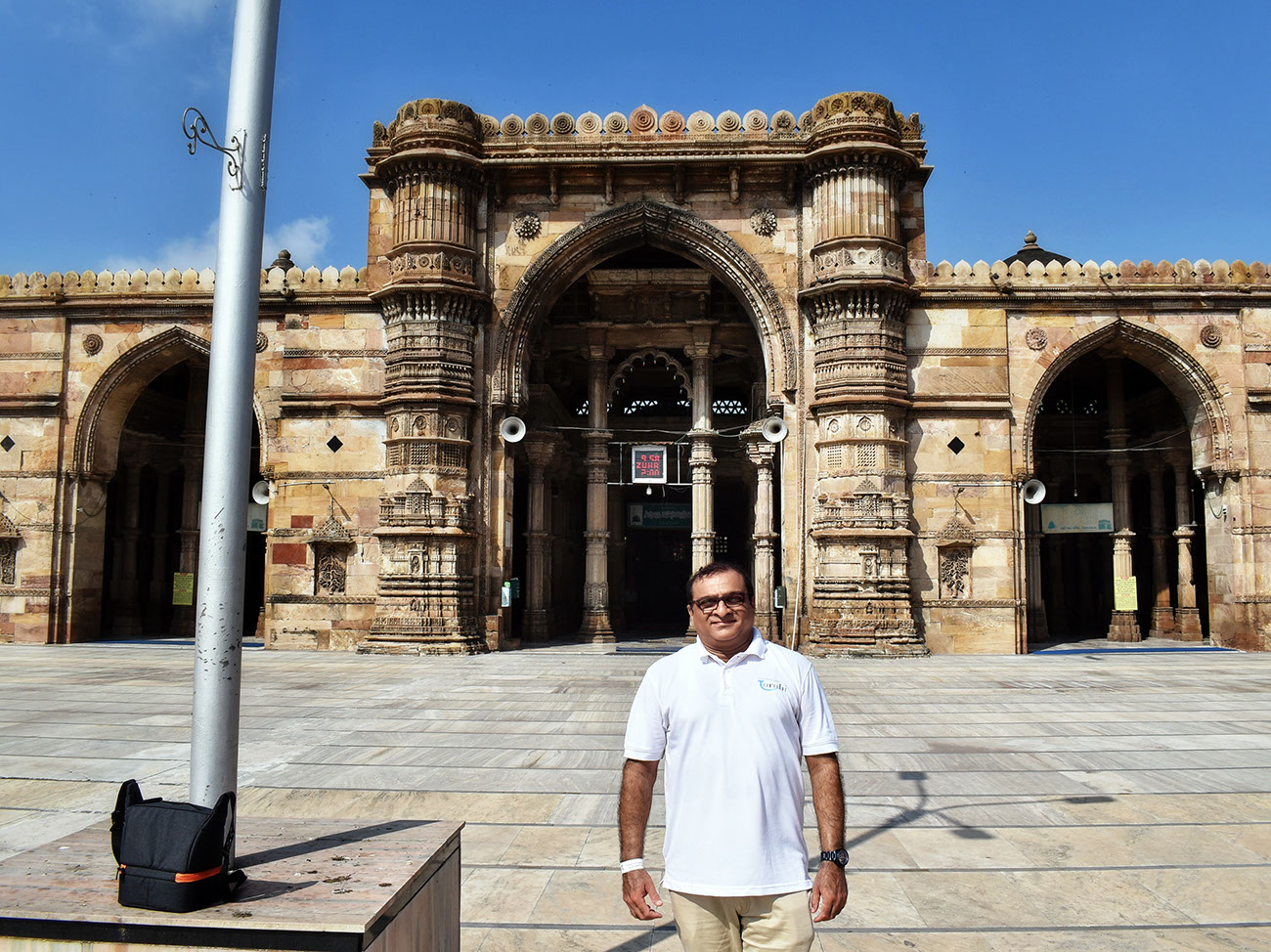
Jami Masjid was built with the support of 260 pillars and has 15 domes
Entry of women into mosques is rare, even today. Jama Masjid was an exception even 500 years ago. Mulak Khana, a dedicated place where women can pray while maintaining their privacy is evidence of this.
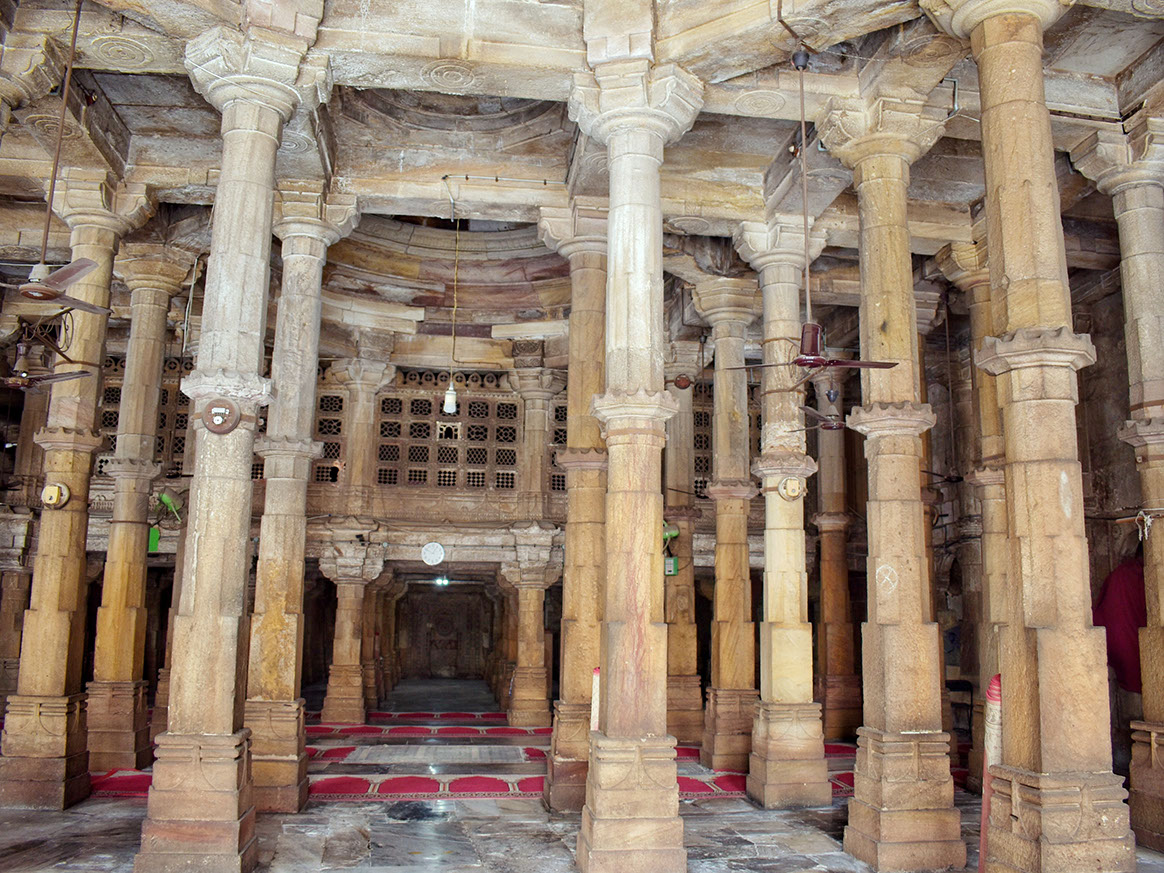
Jharokha style design of Mulak Khana was adopted from Rajput tradition of Rajasthan
The striking aspect of this place is its architecture, a blend of Gujarati and Islamic styles. Many motifs of Hindu and Jain temple architecture are carved in the main pillars.
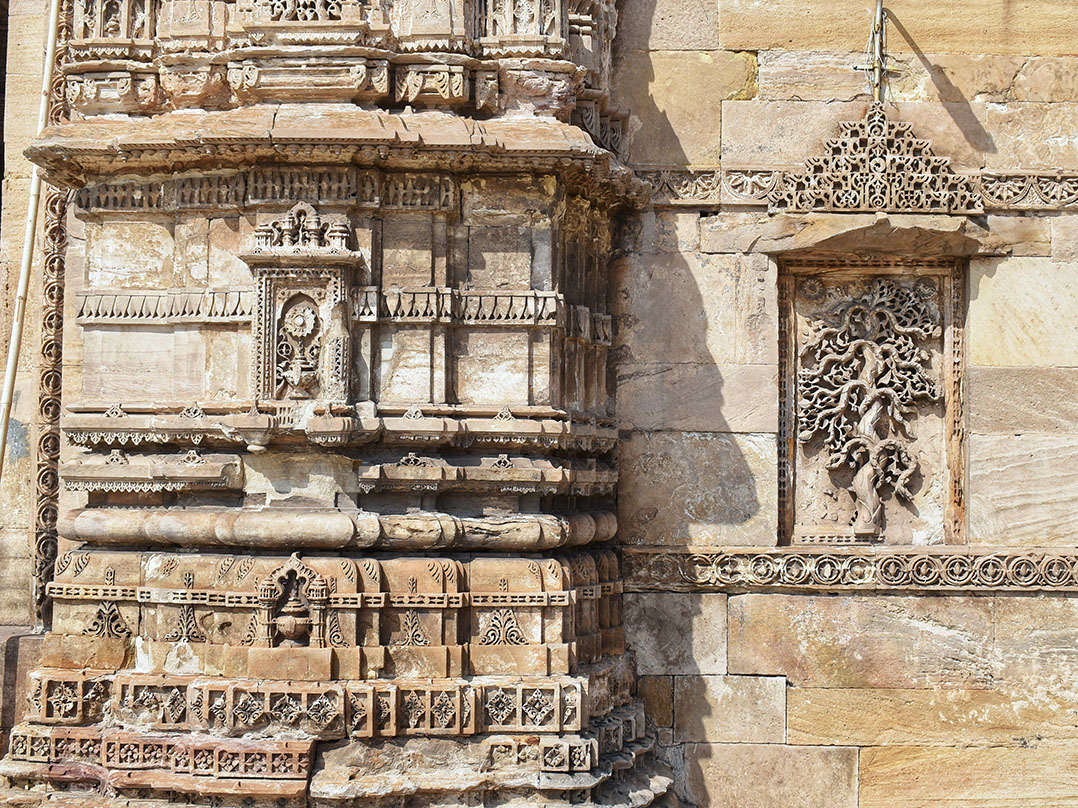
"Kalpavriksha" carving in the main pillar - a wish fulfilling tree in Jainism
Takeaway from an enriching Heritage Walk
A truly enlightening journey, this heritage walk at the UNESCO World Heritage City in India takes one down memory lane to an era where the neighborhoods of Ahmedabad, were socio-culturally homogeneous. An age bygone when unity in diversity was tangible and living. A culture and heritage that we are proud of.
Frequently Asked Questions:
Why is Ahmedabad a UNESCO World Heritage Site?
There is a rich architectural heritage in Ahmedabad that contributes to the local identity and continuity of the city. There are also potential heritage precincts in Ahmedabad in the form of the Pols, the traditional residential clusters of the medieval period, which make the city rather unique. As a result, Ahmedabad has all the characteristics to be the first city in India to be added to UNESCO's 2017 list of World Heritage Cities.
How many heritage places are there in Ahmedabad?
Heritage places are an important part of Ahmedabad's history and culture. There are more than 100 heritage places in the city, including temples, mosques and forts. Many of these heritage places are hundreds of years old and have been carefully preserved. They provide a glimpse into the city's past, and they are also a popular tourist destination. Heritage places are an important part of Ahmedabad's identity, and they play a vital role in its economy.
How do I plan to see all the heritage sites in Ahmedabad?
You may like to start by visiting the Sabarmati Ashram, which was Gandhiji's home for many years. You might also be interested in learning about the city's rich history at the Calico Museum of Textiles. The Sidi Saiyyed Mosque is another must-see, with its beautiful carved stone screens. To get a sense of daily life in Ahmedabad, you want to wander through the narrow streets of the Old City and visit some of the local markets.
What is Ahmedabad famous for?
Ahmedabad is known for its rich history and heritage buildings dating back a few centuries. Today, Ahmedabad is a bustling metropolis with a population of over six million people. It is also the economic and cultural center of Gujarat, home to some of the best schools and universities in the country. But what really makes Ahmedabad special is its food. The city is renowned for its hearty Gujarati cuisine, which often features fresh vegetables and spices.
Disclaimer: This blog may contain affiliate links. At no extra cost to you, we may get a small commission if you buy anything. All products and services we endorse have been personally used or come highly recommended to us. These incomes allow us to keep the community supported and ad-free.
Things To Consider
About the author
Rate the Story
Related Stories
Please share your comment
Sir, the architectural style of the mosque isn't inspired from rajputs from Rajasthan. It is indigenous to Gujarati Rajput style of architecture known as Solanki style.

LOVE IT! I am just amazed that I have been there in the same places in the past but I was surrounded with so much distraction and less information about Ahemdabad Heritage history due to this I never appreciated these places. Thank you so much for this walk of Gujarat's way of living. As being Gujarati my self I love this info and I am going to share it with my friends for sure. Please share more these kinds of stories I simply love the architecture and historical buildings.

Thanks Mithilesh once again. It is an iron that many people living in Ahmedabad do not know about this treasure trove of heritage. I hope this story spreads the words around.
This is a completely new dimension of Ahmedabad that I just loved. I have spent a few days there long ago, but would love to take this walk if at all I happen to be there in the future. Great writeup, by the way.

Absolutely, it was new to me as well even though I have spent over a decade in the city. I'm sure you would love the heritage walk.

I am truly amazed by this part of the city and its architecture. It truly deserved to be in the list of UNESCO World Heritage City. Your pictures are very nice as well the writeup, keep it up.

Thank you for the comment. You are absolutely right, this part of Ahmedabad is truly amazing and Ahmedabad Heritage Walk does all the justice by bringing the glory to travelers.

Heritage walk seems to be a new thing in Ahmedabad. It never crossed my mind that those houses are so old and have a unique blend of architecture. I enjoyed reading it.

I too didn't know about it. But it was worth a walk in the morning with a knowledgeable guide.

Amazing story, I am born and brought up in Ahmedabad but did know it so well, through your story I lived in Ahmedabad again and know it now historically as well,thank you for your reasearch and contributions and I look forward for more.


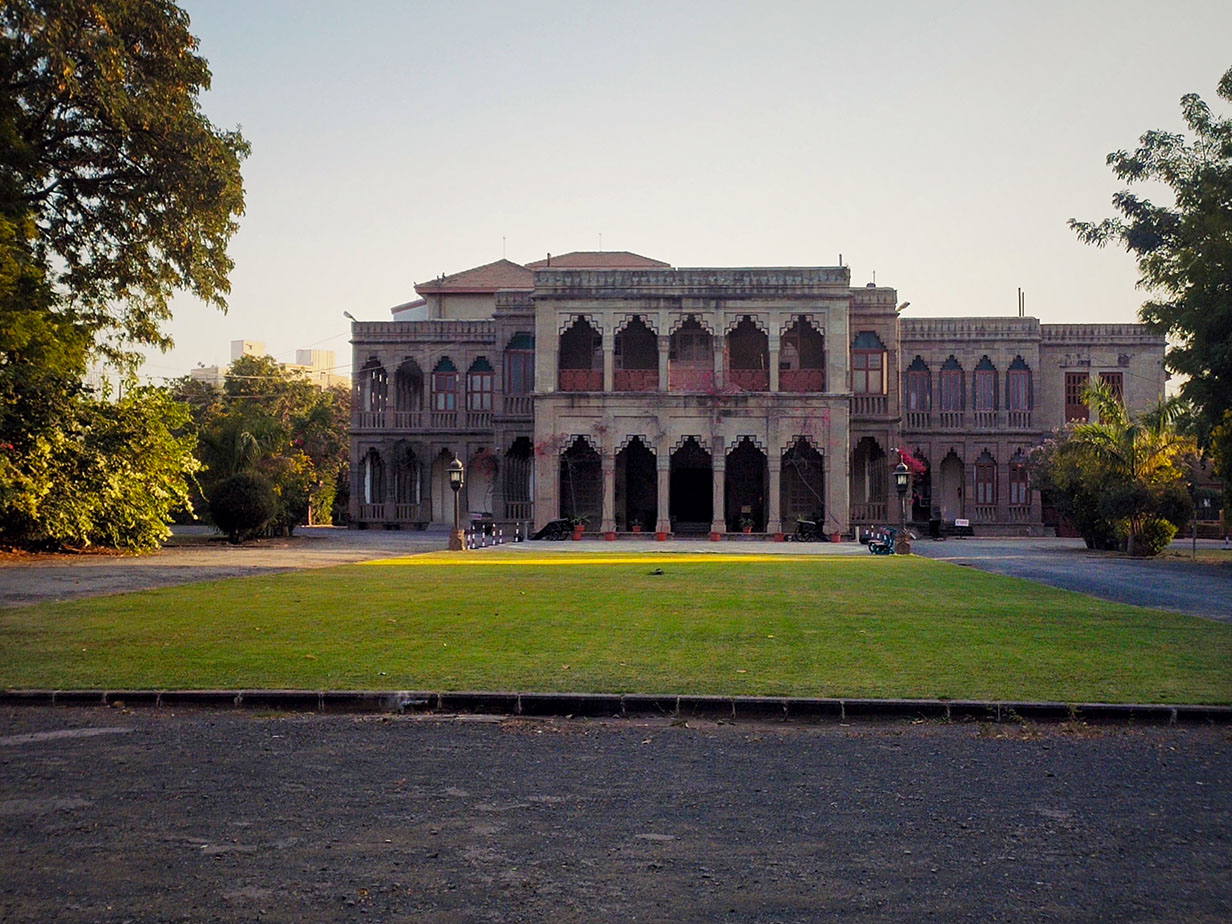
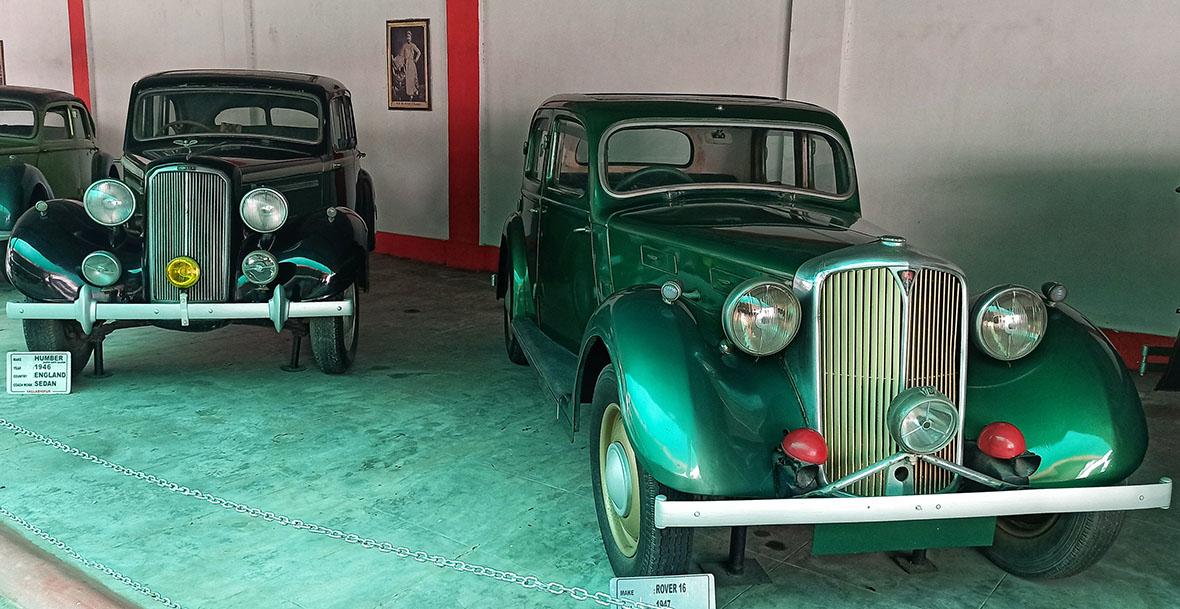
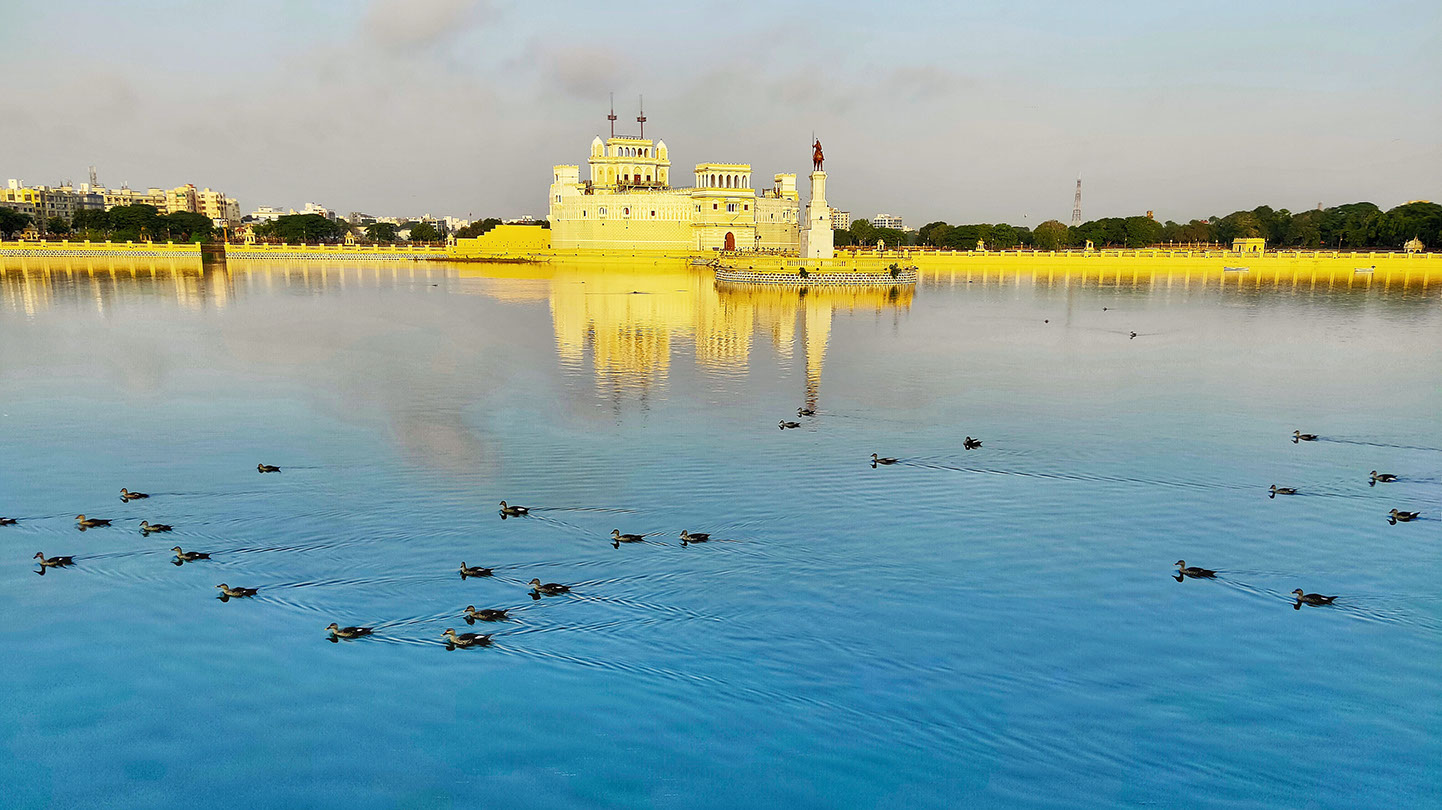
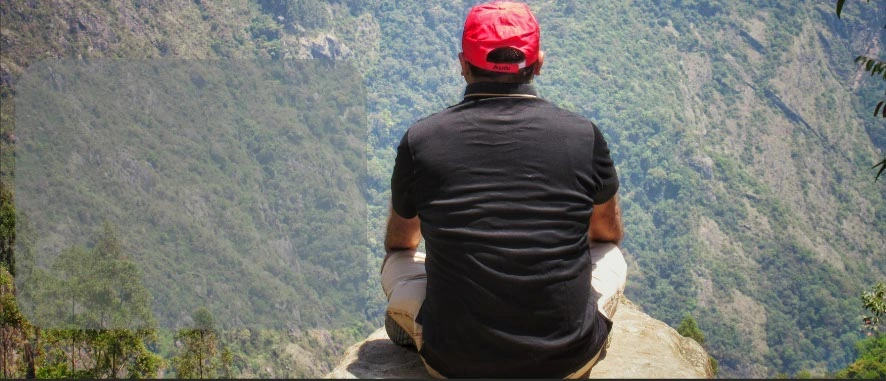

Name
Email
Comment